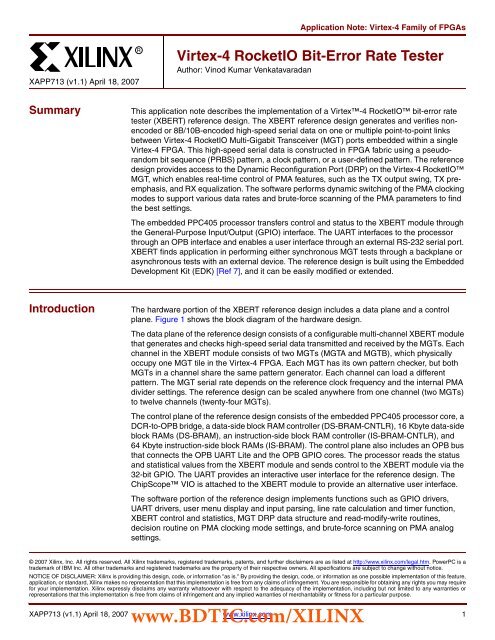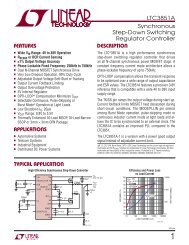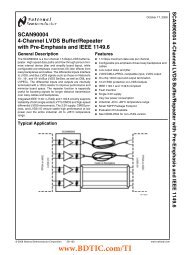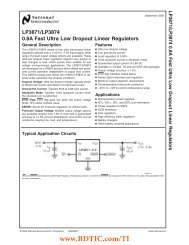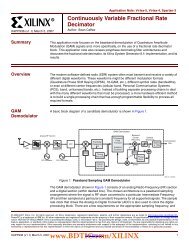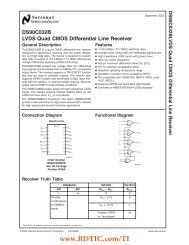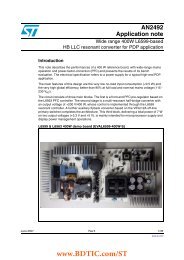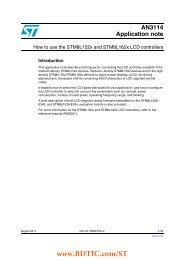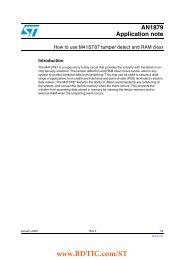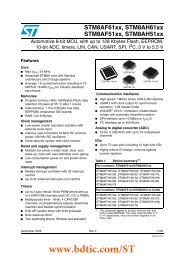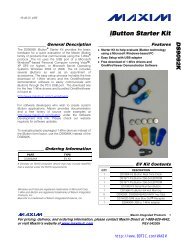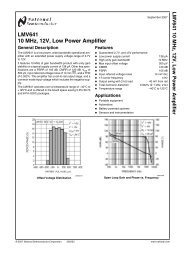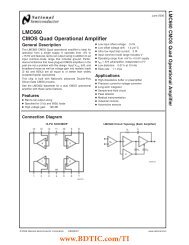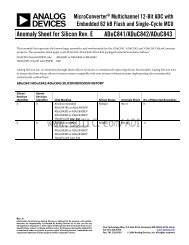Xilinx XAPP713 Virtex-4 RocketIO Bit-Error Rate Tester, application ...
Xilinx XAPP713 Virtex-4 RocketIO Bit-Error Rate Tester, application ...
Xilinx XAPP713 Virtex-4 RocketIO Bit-Error Rate Tester, application ...
- No tags were found...
You also want an ePaper? Increase the reach of your titles
YUMPU automatically turns print PDFs into web optimized ePapers that Google loves.
Application Note: <strong>Virtex</strong>-4 Family of FPGAs<strong>XAPP713</strong> (v1.1) April 18, 2007R<strong>Virtex</strong>-4 <strong>RocketIO</strong> <strong>Bit</strong>-<strong>Error</strong> <strong>Rate</strong> <strong>Tester</strong>Author: Vinod Kumar VenkatavaradanSummaryThis <strong>application</strong> note describes the implementation of a <strong>Virtex</strong>-4 <strong>RocketIO</strong> bit-error ratetester (XBERT) reference design. The XBERT reference design generates and verifies nonencodedor 8B/10B-encoded high-speed serial data on one or multiple point-to-point linksbetween <strong>Virtex</strong>-4 <strong>RocketIO</strong> Multi-Gigabit Transceiver (MGT) ports embedded within a single<strong>Virtex</strong>-4 FPGA. This high-speed serial data is constructed in FPGA fabric using a pseudorandombit sequence (PRBS) pattern, a clock pattern, or a user-defined pattern. The referencedesign provides access to the Dynamic Reconfiguration Port (DRP) on the <strong>Virtex</strong>-4 <strong>RocketIO</strong>MGT, which enables real-time control of PMA features, such as the TX output swing, TX preemphasis,and RX equalization. The software performs dynamic switching of the PMA clockingmodes to support various data rates and brute-force scanning of the PMA parameters to findthe best settings.The embedded PPC405 processor transfers control and status to the XBERT module throughthe General-Purpose Input/Output (GPIO) interface. The UART interfaces to the processorthrough an OPB interface and enables a user interface through an external RS-232 serial port.XBERT finds <strong>application</strong> in performing either synchronous MGT tests through a backplane orasynchronous tests with an external device. The reference design is built using the EmbeddedDevelopment Kit (EDK) [Ref 7], and it can be easily modified or extended.IntroductionThe hardware portion of the XBERT reference design includes a data plane and a controlplane. Figure 1 shows the block diagram of the hardware design.The data plane of the reference design consists of a configurable multi-channel XBERT modulethat generates and checks high-speed serial data transmitted and received by the MGTs. Eachchannel in the XBERT module consists of two MGTs (MGTA and MGTB), which physicallyoccupy one MGT tile in the <strong>Virtex</strong>-4 FPGA. Each MGT has its own pattern checker, but bothMGTs in a channel share the same pattern generator. Each channel can load a differentpattern. The MGT serial rate depends on the reference clock frequency and the internal PMAdivider settings. The reference design can be scaled anywhere from one channel (two MGTs)to twelve channels (twenty-four MGTs).The control plane of the reference design consists of the embedded PPC405 processor core, aDCR-to-OPB bridge, a data-side block RAM controller (DS-BRAM-CNTLR), 16 Kbyte data-sideblock RAMs (DS-BRAM), an instruction-side block RAM controller (IS-BRAM-CNTLR), and64 Kbyte instruction-side block RAMs (IS-BRAM). The control plane also includes an OPB busthat connects the OPB UART Lite and the OPB GPIO cores. The processor reads the statusand statistical values from the XBERT module and sends control to the XBERT module via the32-bit GPIO. The UART provides an interactive user interface for the reference design. TheChipScope VIO is attached to the XBERT module to provide an alternative user interface.The software portion of the reference design implements functions such as GPIO drivers,UART drivers, user menu display and input parsing, line rate calculation and timer function,XBERT control and statistics, MGT DRP data structure and read-modify-write routines,decision routine on PMA clocking mode settings, and brute-force scanning on PMA analogsettings.© 2007 <strong>Xilinx</strong>, Inc. All rights reserved. All <strong>Xilinx</strong> trademarks, registered trademarks, patents, and further disclaimers are as listed at http://www.xilinx.com/legal.htm. PowerPC is atrademark of IBM Inc. All other trademarks and registered trademarks are the property of their respective owners. All specifications are subject to change without notice.NOTICE OF DISCLAIMER: <strong>Xilinx</strong> is providing this design, code, or information "as is." By providing the design, code, or information as one possible implementation of this feature,<strong>application</strong>, or standard, <strong>Xilinx</strong> makes no representation that this implementation is free from any claims of infringement. You are responsible for obtaining any rights you may requirefor your implementation. <strong>Xilinx</strong> expressly disclaims any warranty whatsoever with respect to the adequacy of the implementation, including but not limited to any warranties orrepresentations that this implementation is free from claims of infringement and any implied warranties of merchantability or fitness for a particular purpose.www.BDTIC.com/XILINX<strong>XAPP713</strong> (v1.1) April 18, 2007 www.xilinx.com 1
FeaturesRDS-BRAM(16KB)DS-BRAMCNTLRMulti-ChannelXBERTChannel 0Channel nPPCDCR2OPBBridgeOPBOPBGPIOChipScopeVIOIS-BRAMCNTLROPBUART LiteIS-BRAM(64KB)x713_01_112805Figure 1: Hardware Block Diagram of the XBERT Reference DesignFeaturesThe key features of the <strong>Virtex</strong>-4 XBERT reference design are summarized below:• Modular design scales from 2 to 12 channels that enable up to 24 MGTs in <strong>Virtex</strong>-4 FPGA.• Supports all devices except for XC4VFX12 in the <strong>Virtex</strong>-4 FX family.• Supports any valid <strong>Virtex</strong>-4 MGT serial rate.• Supports dynamic configuration of MGTs through the Dynamic Reconfiguration Port(DRP). Supports changing the serial rate and/or clocking mode on the fly.• Supports 16, 20, 32, and 40-bit wide MGT fabric interface.• Support streaming or framed transmission. Frame length and inter-frame gap isconfigurable.• Supports 8B/10B encoded or non-encoded patterns, including eight ITU-T standard PRBSpatterns (2 7 –1, 2 9 –1, 2 11 –1, 2 15 –1, 2 20 –1, 2 23 –1, 2 29 –1, 2 31 – 1), a configurableuser pattern, an IDLE pattern, and a counter pattern. Each channel can load a differentpattern.• Generates three clock patterns with frequency equal to 1 / 2 , 1 / 10 , or 1 / 20 of the MGT serialrate.• Supports BER test in both synchronous and asynchronous systems. Supports point-topointBER test between any two MGTs on the same FPGA or on different FPGAs.• MGTs in the left and right columns can operate fully asynchronously using differentREFCLK sources.• Supports MGT serial loopback mode. Implements a fabric loopback mode to reflectreceived data back to the transmission port through the FPGA fabric.• Implements a self-synchronized pattern checker that automatically aligns and locks to anincoming pattern. Capable of testing with an external BER tester.• Supports brute-force scanning for finding optimal PMA settings on each MGT.• Supports 64-bit receive word and error counters for long test duration.• Supports error injection on the transmit side to introduce a single bit error to the channel.• Supports UART and ChipScope VIO user interfaces.• Supports design resource reduction by removing unused patterns and/or features from thedesign.www.BDTIC.com/XILINX<strong>XAPP713</strong> (v1.1) April 18, 2007 www.xilinx.com 2
Data Plane DescriptionRData PlaneDescriptionMGT Use ModelTo perform a successful bit-error rate (BER) test, some key features of the <strong>Virtex</strong>-4 MGT mustbe properly controlled. The XBERT reference design incorporates a subset of featuresprovided by the <strong>Virtex</strong>-4 MGT, as listed in Table 1.Table 1: Deployment of <strong>RocketIO</strong> MGT Features in the XBERT Reference DesignLayerPMAPCSSERDES<strong>Virtex</strong>-4 MGT FeaturesAnalog Clock and Data Recovery (CDR)Digital oversampled receiverReceiver signal detect, loss of signal indicator, and out-ofband(OOB) support at both receiver and transmitterOutput swing adjustment and TX pre-emphasisRX continuous-time linear equalizerOn-chip AC couplingUse of TXOUTCLK/RXRECCLK and internal clock dividersSerial loopback and repeater modeTX FIFO and RX Elastic BufferComma Detection and Alignment8B/10B Encoder/Decoder64B/66B Encoder/Decoder, Scrambler, Gearbox, andBlock SyncClock CorrectionChannel BondingParallel loopbackCRC generation and checkingDynamic Reconfiguration Port (DRP)Deployment in theReference DesignTo avoid using clock correction schemes between local and remote ports, all <strong>Virtex</strong>-4 MGTsinstantiated in the reference design use the recovered clock (RXRECCLK1) to clock in theFPGA fabric on the receive side. This makes the reference design capable of performing bothasynchronous and synchronous BER tests, either between two <strong>Virtex</strong>-4 MGTs or between anMGT and external BER test equipment.The reference design supports 16, 20, 32, and 40-bit MGT fabric interfacing, as well as 32-bitand 40-bit MGT internal data width. It can transmit and receive non-encoded data or 8B/10Bencoded data, depending on the choice of the MGT fabric interface and internal data width.Table 2 lists all these options.YesYes and configurableYes and configurableNoYes and configurableYes and configurableYes and configurableYes and configurableYes and configurableYesYes and configurableYes and configurableNoNoNoNoNoYeswww.BDTIC.com/XILINX<strong>XAPP713</strong> (v1.1) April 18, 2007 www.xilinx.com 3
Data Plane DescriptionRTable 2: MGT Data Width and Encoding Options in XBERT Reference DesignMGT Fabric Interface Width(XBERT Data Width)The reference design produces standard PRBS patterns in the serial data stream. In order totransmit and receive raw PRBS patterns, the 8B/10B or 64B/66B coding on a <strong>Virtex</strong>-4 MGTshould be bypassed. Such raw PRBS patterns are considered to be most stressful to the MGTon both run length and DC balance aspects. When 8B/10B is enabled, the run length oftransmission pattern is limited to a maximum 5 bits. The 8B/10B encoder and decoder alsorequire the use of comma detection and alignment in the MGT.Depending on the target line rate, the reference design supports using the analog CDR or thedigital oversampled receiver in the MGT.MGT Clocking SchemeMGT InternalData WidthEncoding/Decoding16 32 None16 40 8B/10B20 40 None32 32 None32 40 8B/10B40 40 NoneFigure 2 shows the distribution of MGT reference clocks in <strong>Virtex</strong>-4 FPGA for a typical4-channel XBERT implementation.Channel 2 Channel 3REFCLK2_LEFT_PREFCLK2_LEFT_NGT11CLK_MGT_LEFT_2REFCLK1GT11_AREFCLK2GREFCLKREFCLK1GT11_AREFCLK2GREFCLKGT11CLK_MGT_RIGHT_2REFCLK2_RIGHT_PREFCLK2_RIGHT_NREFCLK1GT11_BREFCLK2GREFCLKREFCLK1GT11_BREFCLK2GREFCLKSYNCLK2SYNCLK1Channel 0 Channel 1REFCLK1GT11_AREFCLK2REFCLK1GT11_AREFCLK2SYNCLK1SYNCLK2REFCLK1_LEFT_PREFCLK1_LEFT_NGT11CLK_MGT_LEFT_1GREFCLKREFCLK1GT11_BREFCLK2GREFCLKREFCLK1GT11_BREFCLK2GT11CLK_MGT_RIGHT_1REFCLK1_RIGHT_PREFCLK1_RIGHT_NGREFCLKGREFCLKBUFGIBUFGDSGREFCLK_P GREFCLK_NFigure 2: MGT Reference Clock Distribution in XBERT Reference Designwww.BDTIC.com/XILINXX713_02_081505<strong>XAPP713</strong> (v1.1) April 18, 2007 www.xilinx.com 4
Data Plane DescriptionRThe MGT clock distribution in <strong>Virtex</strong>-4 supports the column-based structure. A column consistsof multiple MGT tiles, which contain two MGTs each. Two low-jitter reference clock trees(SYNCLK1 and SYNCLK2) driven by the GT11CLK_MGT modules run the entire length of thecolumn. In a tile, each PLL can select its own RX reference clock and a shared TX referenceclock. There are three reference inputs to choose from: the two SYNCLKs in each column thatdrive the REFCLK1 and REFCLK2 inputs of the MGTs, and the global GREFCLK (for<strong>application</strong>s below 1 Gb/s).There are two GT11CLK_MGT inputs bonded out per column. All four GT11CLK_MGTmodules are instantiated in the XBERT reference design, named as GT11CLK_MGT_LEFT_1,GT11CLK_MGT_LEFT_2, GT11CLK_MGT_RIGHT_1, and GT11CLK_MGT_RIGHT_2. Thefollowing attributes are set on the GT11CLK_MGT_LEFT_1 and GT11CLK_MGT_RIGHT_1modules so that they drive SYNCLK1 for the entire column:SYNCLK1OUTEN = ENABLESYNCLK2OUTEN = DISABLESimilarly, the following attributes are set on the GT11CLK_MGT_LEFT_2 andGT11CLK_MGT_RIGHT_2 modules so that they drive SYNCLK2 for the entire column:SYNCLK1OUTEN = DISABLESYNCLK2OUTEN = ENABLEThe GREFCLK global clock is driven by a single IBUFGDS followed by a BUFG. The XBERTreference design provides a hardware configuration parameter for removing implementation ofGREFCLK, thus saving the cost of this BUFG in the design.Figure 3 illustrates the MGT user clock distribution in a typical four-channel XBERT design.BUFGRCMGT ARX LogicBUFGRCMGT ARX LogicTCRXRECCLK1TXOUTCLK1GT11_X 0Y m+1TX LogicTCRXRECCLK1TXOUTCLK1GT11_X 1Y k+1TX LogicBUFGRCMGT BRX LogicBUFGRCMGT BRX LogicTCRXRECCLK1TXOUTCLK1Channel 2TCRXRECCLK1TXOUTCLK1GT11_X 1Y kChannel 3BUFGRCMGT ARX LogicBUFGRCMGT ARX LogicGT11_X 0Y mGT11_X 1Y j+1TCRXRECCLK1TXOUTCLK1GT11_X 0Y n+1TX LogicTCRXRECCLK1TXOUTCLK1TX LogicBUFGRCMGT BRX LogicBUFGRCMGT BRX LogicBUFGTCRXRECCLK1TXOUTCLK1GT11_X 0Y nChannel 0BUFGTCRXRECCLK1TXOUTCLK1GT11_X 1Y jChannel 1TX Clock Master MGTNote:TC = TXUSRCLK2RC = RXUSRCLK2Figure 3: MGT User Clock Distribution in XBERT Reference Designwww.BDTIC.com/XILINXX713_03_120105<strong>XAPP713</strong> (v1.1) April 18, 2007 www.xilinx.com 5
PRBS Pattern GenerationRRXRECCLK1 from each MGT is fed to a global clock buffer (BUFG) and is used to clock thereceiving-side logic and the RXUSRCLK2 port of the same MGT. This allows asynchronousoperation between TX and RX on each MGT without the need of clock correction.TXOUTCLK1 from one MGTB in each column (called the TX Clock Master MGT) is fed to aBUFG and is used to clock the transmitting-side logic and the TXUSRCLK2 port of all MGTs inthe same column. This TX clocking scheme reduces the number of BUFGs required in thedesign. However, it also creates the following implications:• The MGTs in one column must operate at a single line rate, since all TXUSRCLK musthave the same frequency.• Two columns of MGTs in the FPGA can operate at two different line rates fullyindependently.• The two TX Clock Master MGTs must be activated and operate properly. In particular, theTX PLL of these MGTs must lock properly to the local reference clock. Otherwise, allMGTs in the entire column could be affected.Hardware configuration parameters allow the XBERT reference design to support the followingoptions:• The location of the TX Clock Master MGT can be moved to an MGTB in any channel in thesame column.• A dedicated TXOUTCLK1 can be used for each channel. This results in the TX ClockMaster MGT arrangement being discarded, and allows all the channels to operateindependently of each other.• The same clock used to generate TXUSRCLK2 can drive the RXUSRCLK2. This results inthe use of RXRECCLK1 being discarded and allows TX and RX to operate fullysynchronously.To reduce the number of DCMs required in the system, the reference design does not use aDCM to generate RXUSRCLK and TXUSRCLK. Instead, it uses internal PCS clock dividers toattain the proper ratio between USRCLK and USRCLK2. Note that the MGT parallel loopbackoption becomes invalid when internal clock dividers are used in the design. Refer to UG076,<strong>Virtex</strong>-4 <strong>RocketIO</strong> MGT User Guide [Ref 2] for details regarding the use of internal PCS clockdividers.PRBS PatternGeneration<strong>Bit</strong>-error measurements are an important means of assessing the performance of digitaltransmission. It is necessary to specify reproducible test sequences that simulate real traffic asclosely as possible. Reproducible test sequences are also a prerequisite to perform end-to-endmeasurement. Pseudo-random bit sequences (PRBS) with lengths of 2 n – 1 bits are the mostcommon solution to this problem.The PRBS pattern is produced using a linear-feedback shift register (LFSR) with appropriatefeedback. If the LFSR has n stages, the maximum sequence length is 2 n – 1 bits. If the digitalsignal is taken directly from the output of the LFSR (non-inverted signal), the longest string ofconsecutive zeros is equal to n – 1. If the signal is inverted, n consecutive zeros and n –1consecutive ones are produced. In addition to strings of consecutive zeros and ones, the PRBSpattern contains any possible combination of zeros and ones within a string length dependingon n.For a given polynomial, there are two types of LFSR implementations that yields the equivalentresult:• Fibonacci (or Type-I) LFSR uses exclusive-OR (XOR) gates outside the shift register loop.• Galois (or Type-II) LFSR uses XOR gates inside the shift register chain.From a mathematical perspective, an implementation of multiple-stage LFSRs producing aPRBS pattern can be described by a polynomial. For example, the polynomial x 15 + x 14 +1 canwww.BDTIC.com/XILINX<strong>XAPP713</strong> (v1.1) April 18, 2007 www.xilinx.com 6
Pattern GeneratorRrepresent a Fibonacci LFSR implementation of a 15-stage shift register whose 14th and 15thstage outputs are added in a modulo-two addition stage, with the result fed back to the input ofthe first stage. The polynomial 1 + x 14 + x 15 can represent the equivalent Galois LFSRimplementation from the previous example. For LFSRs with only a few taps, the Fibonacciimplementation generally achieves a faster clock speed than its Galois counterpart.Although faster for a small number of taps, the Fibonacci implementation's performancedegrades as the number of taps increases. The Galois implementation, however, sees hardlyany performance loss with an increase in the number of taps. The PRBS pattern generatordesigned in the XBERT reference design deploys a Fibonacci (Type-I) LFSR by default, but canswitch to Galois LFSR using a compilation option.PatternGeneratorThe pattern generator in the XBERT reference design generates either 16, 20, 32, or 40-bitpatterns to work with a 16, 20, 32, or 40-bit MGT fabric interface. Figure 4 shows the blockdiagram of a pattern generator. The pattern generator contains 14 individual pattern generationblocks. The outputs of these blocks are multiplexed and registered, and they are provided aseither 16, 20, 32, or 40-bit data outputs (data_out).seed_in [39:0]seed_k_in [1:0]immediate_modeenable_inresetclock_inen_8b10bCLK_2BITCLK_10BITCLK_20BITPRBS7PRBS9PRBS23PRBS29PRBS31inverterror_injectdata_out[15/19/31/39:0]k_out[1:0]PRBS11IDLEPRBS15USERPRBS20CNTRusr_pattern[39:0]pat_id[3:0]framedFramingFSMIFG CounterFrame LengthCounterifg_len[7:0]frame_len[15:0]x713_04_050106Figure 4: Pattern Generator Block DiagramTable 3 summarizes all the patterns and their respective polynomials implemented in theXBERT reference design. Note that user can remove one or more patterns from the design forresource reduction.Table 3 summaries the use model of each pattern supported in the XBERT reference design.The pattern generator implements seven different polynomials (PRBS9,11,15, 20, 23, 29, and31) as specified in ITU-T Recommendation O.150 for PRBS pattern generation [Ref 8]. TheInternational Telecommunication Union (ITU) is an international organization within the UnitedNations System, where governments and the private sector coordinate global telecomnetworks and services. ITU-T Recommendation O.150 contains general requirementsapplicable to instrumentation for performance measurements on digital transmissionequipment. By alternating PRBS patterns, the reference design can produce different levels ofline stress on the <strong>Virtex</strong>-4 <strong>RocketIO</strong> MGTs.www.BDTIC.com/XILINX<strong>XAPP713</strong> (v1.1) April 18, 2007 www.xilinx.com 7
Pattern GeneratorRTable 3: Supported Patterns in the XBERT Reference DesignPatternIDPatternNamePattern/PolynomialLength ofSequence(bits)ConsecutiveZerosNotes0 1/2X Clock 101010... 2 0This pattern can be used as a clock patternwhose frequency is equal to 1 / 2 of the MGTserial speed, generating up to a 5 GHzdifferential clock on the transceiver serialoutputs. This pattern also can be used as ahigh-frequency test pattern as defined in IEEEStd 802.3-2002 [Ref 9].11/10X or1/8X Clock5 ones, 5 zerosor4 ones, 4 zeros10 or 8 5 or 4This pattern can be used as a clock patternwhose frequency is equal to 1 / 10 or 1 / 8 of theMGT serial speed, generating up to a 1.3 GHzdifferential clock on the transceiver serialoutputs. This pattern can also be used as alow- frequency test pattern as defined in IEEEStd 802.3-2002 [Ref 9].21/20X or1/16XClock10 ones, 10 zerosor8 ones, 8 zeros20 or 16 10 or 8This pattern can be used as a clock patternwhose frequency is equal to 1 / 20 or 1 / 16 of theMGT serial speed, generating up to a645 MHz differential clock on the transceiverserial outputs.32 7 – 1PRBSx 7 + x 6 +1(non-inverted signal)2 7 – 1 7Uses a proprietary polynomial that is not anITU-T standard.42 9 – 1PRBSx 9 + x 5 +1(non-inverted signal)2 9 – 1 8ITU-T Recommendation O.150, Section 5.1[Ref 8].52 11 – 1PRBSx 11 + x 9 +1(non-inverted signal)2 11 – 1 10ITU-T Recommendation O.150, Section 5.2[Ref 8].62 15 – 1PRBSx 15 + x 14 +1(non-inverted signal)2 15 – 1 15ITU-T Recommendation O.150, Section 5.3[Ref 8]. This is one of the recommended testpatterns in the SONET specification.72 20 – 1PRBSx 20 + x 3 +1(non-inverted signal)2 20 – 1 19ITU-T Recommendation O.150, Section 5.4[Ref 8]. This is one of the recommended testpatterns in the SONET specification.82 23 – 1PRBSx 23 + x 18 + 1 (inverted signal) 2 23 – 1 23ITU-T Recommendation O.150, Section 5.6[Ref 8]. This is one of the recommended testpatterns in the SONET specification.92 29 – 1PRBSx 29 + x 27 + 1 (inverted signal) 2 29 – 1 29ITU-T Recommendation O.150, Section 5.7[Ref 8].102 31 – 1PRBSx 31 + x 28 + 1 (inverted signal) 2 31 – 1 31ITU-T Recommendation O.150, Section 5.8[Ref 8]. This is a recommended PRBS testpattern for 10 Gigabit Ethernet. See IEEE Std802.3ae-2002 [Ref 10].11 Reservedwww.BDTIC.com/XILINX<strong>XAPP713</strong> (v1.1) April 18, 2007 www.xilinx.com 8
Pattern GeneratorRTable 3: Supported Patterns in the XBERT Reference Design (Continued)PatternIDPatternNamePattern/PolynomialLength ofSequence(bits)ConsecutiveZerosNotesK28.5+, K28.5-, K28.5+, . . .(if 8B/10B bypassed and XBERTdata width is 20 or 40 bits)or12IdlePatternK28.5, D16.2, K28.5, D16.2, . . .(if 8B/10B enabled)orA1A1A1A1A2A21A2A2(0xF6F6F6F628282828) ...(if 8B/10B bypassed and XBERTdata width is 16 or 32 bits)20 or 64 5Contains a repeated 16, 20, 32,or 40-bit configurable pattern.13UserPatternIf 8B/10B is enabled, this patterncan be configured as acombination of a K-characterand/or a data character.If 8B/10B is bypassed, the usercan specify any 16, 20, 32, or40-bit pattern, depending on theXBERT data width selected.1 to 40 0 to 39See Table 5 for a bit-mapping of the userpattern.This pattern cannot be all zeros or all onesproducing invalid data with an out-of-range runlength.14 Reserved0000000000,1111111111,...(40-bit XBERT)or15CounterPattern00000000,11111111,...(32-bit XBERT)or00000,11111,...(20-bit XBERT)or0000,1111,...(16-bit XBERT)Approximatelyfrom 320 (in20-bit XBERT)to 640 (in40-bit XBERT)16 to 40www.BDTIC.com/XILINX<strong>XAPP713</strong> (v1.1) April 18, 2007 www.xilinx.com 9
Pattern GeneratorRTable 4: Use Model of Supported Patterns in the XBERT Reference DesignPattern Type Pattern ID 8B/10BFramedTransmissionCommaAlignmentClock patterns 0 to 2 Off Off OffPRBS patterns 3 to 10Idle pattern 12User pattern 13Counter pattern 15Off Off OffOn On OnThe idle pattern (IDLE) can be any one of the following patterns depending on the data widthand encoding scheme selected. An idle pattern is composed of 2-byte or 8-byte idle word. Theidle word is also used to fill-in inter-frame gap in framed transmission, which requires wordalignment using the comma detection and alignment circuits inside the MGT.• 8B/10B is bypassed. The XBERT data width is 20-bit or 40-bit. The idle pattern consists ofinterleaving K28.5 + (0b0011111010) and K28.5 – (0b1100000101) symbols. Thecomma pattern is configured as the K28.5 + character in this case so that the MGT dataoutput can be 2-byte aligned.• 8B/10B is bypassed. The XBERT data width is 16-bit or 32-bit. The idle pattern consists ofthe A1A1A1A1A2A2A2A2 comma pattern (0xF6F6F6F628282828) typically used inSONET <strong>application</strong>s. The MGT data output can be 4-byte aligned.• 8B/10B is enabled. The idle pattern consists of K28.5 and D16.2. The K28.5 character isconfigured as the MGT comma pattern. The MGT data output can be 2-byte aligned.The counter pattern (CNTR) consists of 16, 20, 32, or 40-bit incremental counter words and idlewords, providing a traceable and predictable test pattern that differs from the PRBS pattern.The design concatenates 4-bit counter values to build up the counter word so it repeats every16 user clock cycles. Since the framed transmission of a counter pattern requires completion ofMGT comma detection and alignment, the counter pattern can be used to test commadetection and alignment functions provided by the MGTs.The user pattern (USER) contains a repeated 16, 20, 32, or 40-bit configurable pattern. Table 5lists the bit-mapping of the user pattern input (usr_pattern[39:0]) to the pattern generator.Note: It is advisable to choose a user pattern different from the idle pattern if transmitting an 8B/10Bencodeduser pattern. Otherwise, misalignment of the MGT data output could occur.OffOnOffOnOff Off OffOn On OnOffOnOnOnwww.BDTIC.com/XILINX<strong>XAPP713</strong> (v1.1) April 18, 2007 www.xilinx.com 10
Pattern GeneratorRTable 5: User Pattern <strong>Bit</strong> Mapping<strong>Bit</strong> Locationusr_pattern[39:0]8B/10BONData Width16 <strong>Bit</strong>s8B/10BOFF8B/10BONData Width32 <strong>Bit</strong>s8B/10BOFFData Width20 <strong>Bit</strong>s8B/10BOFFData Width40 <strong>Bit</strong>s8B/10BOFF[7:0]8-bit 8B/10Bcharactertransmittedsecond8-bit patterntransmittedsecond8-bit 8B/10Bcharactertransmitted last8-bit patterntransmitted last[8]1: bit[7:0] is aK-character0: bit[7:0] is adata character(Not Used)1: bit[7:0] is aK-character0: bit[7:0] is adata character(Not Used)10-bit patterntransmittedsecond10-bit patterntransmitted last[9](Not Used)(Not Used)[17:10]8-bit 8B/10Bcharactertransmitted first8-bit patterntransmitted first8-bit 8B/10Bcharactertransmitted third8-bit patterntransmitted third[18]1: bit[17:0] is aK-character0: bit[17:0] is adata character1: bit[17:0] is aK-character0: bit[17:0] is adata character(Not Used)10-bit patterntransmitted first10-bit patterntransmitted third[19](Not Used)[27:20]8-bit 8B/10Bcharactertransmittedsecond8-bit patterntransmittedsecond[28](Not Used)1: bit[27:0] is aK-character0: bit[27:0] is adata character(Not Used)10-bit patterntransmittedsecond[29](Not Used)(Not Used)(Not Used)[37:30]8-bit 8B/10Bcharactertransmitted first8-bit patterntransmitted first[38]1: bit[37:0] is aK-character0: bit[37:0] is adata character(Not Used)10-bit patterntransmitted first[39](Not Used)www.BDTIC.com/XILINX<strong>XAPP713</strong> (v1.1) April 18, 2007 www.xilinx.com 11
Pattern CheckerRThe pattern generator contains a finite state machine (FSM) to delimit the output pattern byperiodically inserting idle words. A word is either a 16, 20, 32, or 40-bit vector determined by thedata width of the MGT fabric interface. Idle words — K28.5 +/– symbols, K28.5 and D16.2characters, or A1A1A1A1A2A2A2A2 comma patterns — are used to fill inter-frame gaps(IFGs). The frame length and the IFG are configurable through the frame length input(frame_len) and the IFG length input (ifg_len) ports.The pattern generator works in either immediate mode (immediate_mode = 1) or self-advancemode (immediate_mode = 0). In immediate mode, the pattern generator takes the 40-bit seedvalue (seed_in) to calculate and output the pattern in three clock cycles. The output pattern isa direct-computed result of the seed value and the internal polynomial. In self-advance mode,the pattern generator calculates and updates the output pattern every clock cycle. The outputpattern is an accumulated result of the initial seed value and the internal polynomial.The pattern generator can inject a single error into the output pattern through the error injectioncontrol port (error_inject). When this port is asserted High, bit 0 on the output is flipped tointroduce a single bit error into the transmission. This function is implemented to self-check theintegrity of the pattern generator and checker in the reference design.The pattern generator can invert the output pattern controlled by the invert port. PRBS 2 15 –1,2 23 –1, 2 29 – 1, and 2 31 – 1 are specified as inverted patterns by default in ITU-TRecommendation O.150. ITU-T considers the inverted patterns as being more stressful thannon-inverted patterns when testing the clock recovery circuit in the network terminatingdevices. The pattern generator inverts these patterns by default, but allows the user to invertthe patterns back in order to link up with a non-standard external BER tester.The PRBS 2 7 – 1 pattern implemented in the reference design uses a proprietary polynomialbecause ITU-T does not provide a recommendation for this type of PRBS. The XBERT cannotlink up with an external BER tester using this PRBS 2 7 – 1 pattern unless it uses the samepolynomial.The pattern generator contains heavy combinatorial logic (for example, a 40-bit carry chain) forparallel PRBS pattern generation that must meet the 163 MHz timing target in order to supporta 6.5 Gb/s data rate.Pattern CheckerThe pattern checker in the XBERT reference design can verify either 16, 20, 32, or 40-bitincoming data from a 16, 20, 32, or 40-bit MGT fabric interface. Figure 5 shows a block diagramof a pattern checker. The pattern checker contains another instance of the pattern generatorthat is identical to the one on the transmission side. This pattern generator generates anexpected pattern to compare with the incoming data. Depending on the comparison result, thelink detection and bit-error measurement are conducted at every clock cycle.www.BDTIC.com/XILINX<strong>XAPP713</strong> (v1.1) April 18, 2007 www.xilinx.com 12
Pattern CheckerRresetrx_clocken_8b10bWordAlignmentControlIdle Detectidle_detecteddata_in[15/19/31/39:0]shiftr0 r1 r2 r3k_in [1:0]clock_inSeedXORusr_pattern[39:0]pat_id[3:0]framedFramingFSMPatternGeneratorLink Detectimmediate_mode<strong>Bit</strong> Counterlinkerrored_bits[5:0]Figure 5: Pattern Checker Block Diagrambit_errorx713_05_050106When the pattern checker receives framed data, it needs to recover the frame boundary bydetecting the idle words within the incoming data IFG. Since the idle word is a 16, 20, 32, or40-bit value, searching the idle word in the incoming data stream requires completion of wordalignment. Word alignment, handled in the pattern checker, works in conjunction with thecomma alignment inside the MGT. The pattern checker contains a finite state machine (FSM)that delimits the received framed pattern and holds the embedded pattern generator during theIFG.The pattern checker works in either immediate mode (immediate_mode = 1) or self-advancemode (immediate_mode = 0). The pattern checker always starts in immediate mode when thelink is down or reset is asserted. As illustrated in Figure 6, the pattern checker in immediatemode uses the incoming data to generate the seed value for the embedded pattern generator.The pattern generator uses the seed value to generate an output pattern in three clock cycles.This output pattern is expected to match the next incoming data.In actual practice, several pipeline stages are introduced on the incoming data path tocompensate for the three-cycle delays in the pattern generator and to meet an optimal timingtarget for 6.5 Gb/s operation. Therefore, the pattern checker can automatically adapt theinternal state of the incoming data’s polynomial to generate the expected data. The patternchecker repeats this process for every cycle until the expected data is aligned and locked on arecognized pattern in the incoming data. The process of watching for and declaring patternmatch (or link-up) is performed by the link detection logic.As soon as link-up is declared, the pattern checker switches to the self-advance mode. In thisstate, the embedded pattern generator starts to independently calculate and update theexpected pattern on every clock cycle. As long as the link is up and stable, any bit error on theincoming data cannot disturb the actual output of the pattern checker, guaranteeing properpattern verification and BER result. This self-synchronization mechanism eliminates the needof transferring a special sequence during the initialization of a BER test, and makes thereference design capable of linking with an external BER tester.www.BDTIC.com/XILINX<strong>XAPP713</strong> (v1.1) April 18, 2007 www.xilinx.com 13
Pattern CheckerRIncoming DataData(n+2)Data(n+1)Data(n)Data(n-1)== =Expected DataData’(n+2)Data’(n+1)Data’(n)SeedPattern Generatorx713_06_071205Figure 6: Self Synchronized Pattern CheckerFigure 7 shows the state diagram of the link detection logic implemented in the pattern checker.The link detection logic monitors the number of bit errors in the received data at each cycle toreport the link status. The logic declares a link-up whenever it sees error-free incoming data forseven or more consecutive clock cycles. It declares a link-down whenever it sees one or morebit errors at each cycle for seven or more consecutive clock cycles. The link status remainsunchanged for all other conditions. The link detection logic filters out any scattered random biterrors occurring at a medium or low bit-error rate (BER) to keep the link relatively stable duringa BER test.reset = 1link = 0err_cnt = 0b10000000bit_error = 1bit_error = 0bit_error = 1bit_error = 0err_cnt =0b10000000bit_error = 1link = 0err_cnt >> 1link = 0err_cnt
Single-Channel XBERT ModuleRSingle-ChannelXBERT ModuleThe single-channel XBERT is a self-contained module providing all necessary BER testfunctions, independent of the PPC405 subsystem. The single-channel XBERT module is amodular design that can be scaled to multiple channels in the FPGA fabric.Figure 6 shows the block diagram of a single-channel XBERT module implemented in theXBERT reference design. A single-channel XBERT module consists of the following maincomponents:• An MGT tile containing two <strong>Virtex</strong>-4 <strong>RocketIO</strong> MGTs (MGTA and MGTB)Both MGTs share the buffered TXUSRCLK2; therefore they must operate at the same TXdata rate.• Two pattern checkers connecting to two MGTs• One pattern generator shared by two MGTs• One clock/reset module generating two independent RXUSRCLK2 for two MGTsThis module contains two global clock buffers (BUFGs) for buffering RXRECCLK1 fromeach MGT and generating RXUSRCLK2. It also generates clock status outputs(dcm_locked_rx) by detecting RXRECCLK1.• Two comma align control modules connecting to two MGTsThese modules are enabled when comma_align_enable is High. Each module attaches toone MGT for toggling the ENPCOMMAALIGN and ENMCOMMAALIGN ports. It indicatesaligned and disables comma alignment on the MGT once the pattern checker indicateslink-up and detects seven idles in the incoming data.• Two bit error counters for two pattern checkersEach counter aggregates the number of erroneous bits detected in the pattern checker intoa 32-bit value. Each counter is updated at every clock cycle and can be cleared by adedicated reset (ber_cnt_reset).The XBERT reference design uses the DSP48 block in the <strong>Virtex</strong>-4 FPGA as the 32-bitcounter in order to improve timing performance and save fabric resources. The user canremove the use of DSP48 by asserting a compile option.• Two RX word counters for two MGTsEach counter is a free-running 32-bit counter on the RXUSRCLK2 domain that produces atotal number of received words. This counter only increases when the MGT RX PLL islocked. This number is necessary for calculating a BER. The user can issue a dedicatedreset (ber_cnt_reset) to clear each counter.• Two shallow asynchronous FIFOs for two MGTsThese FIFOs provide the fabric loopback function that reflects the incoming data back tothe transmission. Each FIFO is a 16-deep asynchronous FIFO constructed using the dualportdistributed RAM. The write port is clocked on RXUSRCLK2, and the read port isclocked on TXUSRCLK2. These buffers can handle phase differences (but not frequencydifferences) between two clocks. When fabric loopback is enabled, it requires that theincoming data be frequency-locked to the local reference clock, as in a synchronousoperation.• Two Calibration Blocks for two MGTsThe calibration block is attached to each MGT to perform calibration and monitoringfunctions. The default calibration block used in this reference design is v1.4.1.• One ChipScope Pro ILA coreThis core is clocked on the RXUSRCLK2 signal of either MGTA or MGTB. Data from bothMGTs and associated internal logic are multiplexed by the mgt_sel input before being fedinto the ILA core so that the selected MGT data can be displayed on ChipScope ProAnalyzer.www.BDTIC.com/XILINX<strong>XAPP713</strong> (v1.1) April 18, 2007 www.xilinx.com 15
Multi-Channel XBERT ModuleRCommaAlign ControlAaligned_0RXRECCLK1MGTARXDATATXDATAPatternCheckerA<strong>Bit</strong> <strong>Error</strong>Counter AAsync FIFOARx WordCounter Alink_0err_bit_count_0rx_word_count_0Clock/ResetPatternGeneratorTXDATARx WordCounter Brx_word_count_1RXDATAAsync FIFOBRXRECCLK1MGTBPatternCheckerB<strong>Bit</strong> <strong>Error</strong>Counter Berr_bit_count_1link_1CommaAlign ControlBaligned_1ChipScopeILA CoreFigure 8: Single-Channel XBERT Modulex713_08_112805Multi-ChannelXBERT ModuleThe multi-channel XBERT module contains multiple instances (channels) of the single-channelXBERT module, grouped into left and right channels using a default placement configuration.Figure 9 is a block diagram of the multi-channel XBERT module. In this example, MGTs areplaced at opposite sides of the FPGA, where even channels instantiate MGTs at the left side ofthe FPGA, and odd channels instantiate MGTs at the right side of the FPGA.The multi-channel XBERT module provides a GPIO interface that can attach to amicroprocessor (for example, PPC405 processor). The GPIO provides register-based controland status over 32 input pins and 32 output pins. To expand the number of control/status bitstransferring from/to the microprocessor on the GPIO interface, multiple control/status vectorsare memory mapped to the GPIO interface at different addresses.www.BDTIC.com/XILINX<strong>XAPP713</strong> (v1.1) April 18, 2007 www.xilinx.com 16
Multi-Channel XBERT ModuleRRESETSYSCLKChipScopeVIOChannel 1( Right )GT11CLK_MGTGT11CLK_MGTREFCLK1_RIGHT_PREFCLK1_RIGHT_NREFCLK2_RIGHT_PREFCLK2_RIGHT_NGPIO_OUT[0:31]GPIO_ENGPIO_IN[0:31]ChannelStatusMultiplexerChannelControlMultiplexerClockModule( Right )ClockModule( Left )GREFCLK[c –1:0]TXP[c * 2–1:0]TXN[c * 2–1:0]RXP[c * 2–1:0]RXN[c * 2–1:0]TXOUTCLK1_OUT[c * 2–1:0]RXRECCLK1_OUT[c * 2–1:0]TXOUTCLK2_OUT[c * 2–1:0]RXRECCLK2_OUT[c * 2–1:0]LEDS[19:0]HEADERS[4:0]SUPERCLK_CTRL[8:0]Channel 0( Left )GT11CLK_MGTGT11CLK_MGTFigure 9: Multi-Channel XBERT ModuleREFCLK1_LEFT_NREFCLK1_LEFT_NREFCLK2_LEFT_NREFCLK2_LEFT_Nx713_09_101705The user-accessible ports on the multi-channel XBERT module are defined in Table 6. TheGPIO interface signals (GPIO_IN and GPIO_OUT) use big-endian bit ordering while theremaining signals on the multi-channel XBERT module use little-endian bit ordering.Table 6: Interface Signals of the Multi-Channel XBERT ModuleName Direction DescriptionSYSCLK Input System Clock. Typically 50Mhz.RESET Input System Reset.GPIO_IN[0:31]GPIO_OUT[0:31]<strong>XAPP713</strong> (v1.1) April 18, 2007 www.xilinx.com 17InputOuputGPIO_EN Input GPIO enable signal.REFCLK1_RIGHT_P,REFCLK1_RIGHT_NREFCLK2_RIGHT_P,REFCLK2_RIGHT_NREFCLK1_LEFT_P,REFCLK1_LEFT_NREFCLK2_LEFT_P,REFCLK2_LEFT_NGREFCLK[c –1:0] (1)TXP[c * 2 – 1:0],TXN[c * 2 – 1:0]InputInputInputInputInputOutputwww.BDTIC.com/XILINX32-bit GPIO input from the microprocessor,synchronous to SYSCLK.32-bit GPIO output to the microprocessor,synchronous to SYSCLK.High-speed dedicated reference clock to theMGTs in the right column.Alternative high-speed dedicated referenceclock to the MGTs in the right column.High-speed dedicated reference clock to theMGTs in the left column.Alternative high-speed dedicated referenceclock to the MGTs in the left column.Global reference clock to the MGT tiles usedfor low speed <strong>application</strong>s(
Multi-Channel XBERT ModuleRTable 6: Interface Signals of the Multi-Channel XBERT Module (Continued)RXP[c * 2–1:0],RXN[c * 2 – 1:0]TXOUTCLK1_OUT[c * 2 – 1:0]RXRECCLK1_OUT[c * 2 – 1:0]TXOUTCLK2_OUT[c * 2 – 1:0]RXRECCLK2_OUT[c * 2 – 1:0]LEDS[19:0]HEADERS[4:0]SUPERCLK_CTRL[8:0]Name Direction DescriptionInputOutputOutputOutputOutputOutputOutputOutputNotes:1. c is the number of channels implemented in the XBERT reference design.MGT differential ports that receive serial data.Each Channel inputs two bits as follows: <strong>Bit</strong> 0is the input of MGTA in the channel. <strong>Bit</strong> 1 isthe input of MGTB in the channel.Non-buffered TXOUTCLK1 outputs fromevery MGTs implemented in the design. Eachchannel outputs two bits as follows: <strong>Bit</strong> 0 isthe output of MGTA in the channel, and <strong>Bit</strong> 1is the output of MGTB in the channel.Non-buffered RXRECCLK1 outputs fromevery MGT implemented in the design. Eachchannel outputs two bits as follows: <strong>Bit</strong> 0 isthe output of MGTA in the channel, and <strong>Bit</strong> 1is the output of MGTB in the channel.Non-buffered TXOUTCLK2 outputs fromevery MGTs implemented in the design. Eachchannel outputs two bits as follows: <strong>Bit</strong> 0 isthe output of MGTA in the channel, and <strong>Bit</strong> 1is the output of MGTB in the channel.Non-buffered RXRECCLK2 outputs fromevery MGT implemented in the design. Eachchannel outputs two bits as follows: <strong>Bit</strong> 0 isthe output of MGTA in the channel, and <strong>Bit</strong> 1is the output of MGTB in the channel.<strong>Bit</strong>s 9 to 0 indicate the link status of all MGTsimplemented on the left side. <strong>Bit</strong>s 1 and 0correspond to the MGTB and MGTA withinchannel 0. <strong>Bit</strong>s 9 and 8 correspond to theMGTB and MGTA within channel 8.<strong>Bit</strong>s 19 to 10 indicate the link status of allMGTs implemented on the right side. <strong>Bit</strong>s 11and 10 correspond to the MGTB and MGTAwithin channel 1. <strong>Bit</strong>s 19 and 18 correspondto the MGTB and MGTA within channel 9.<strong>Bit</strong> 0 is the SYSCLK. <strong>Bit</strong> 1 is the GREFCLK[0].<strong>Bit</strong>s 2 to 4 are unused.Optional control outputs to the SuperClockmodule used in <strong>Xilinx</strong> ML42x platform.Table 7 and Table 8 list the bit definitions of the 32-bit GPIO input (GPIO_IN) and GPIO output(GPIO_OUT) registers, respectively.www.BDTIC.com/XILINX<strong>XAPP713</strong> (v1.1) April 18, 2007 www.xilinx.com 18
Multi-Channel XBERT ModuleRTable 7: <strong>Bit</strong> Definitions of the 32-bit GPIO Input (GPIO_IN[0:31])<strong>Bit</strong> Vector Name Description[0:1] OPCODEOperation Code.0b11: GPIO write operation. GPIO_IN carries a controlvector (CTRL) at the current cycle. The address of thiscontrol vector is set by ADDR at the current cycle.0b01: GPIO read operation. GPIO_OUT carries a statusvector (STAT) at the next cycle. The address of thisstatus vector is set by ADDR at the current cycle.Others: Reserved[2:4] ADDR Address of the control or status vector.[5] N/A Reserved.[6:31] CTRL26-bit control vector transferred from the microprocessor to thedata plane (the XBERT module). See Table 9 for bit definitions ofthis vector.Table 8: <strong>Bit</strong> Definitions of the 32-bit GPIO Output (GPIO_OUT[0:31])<strong>Bit</strong> Vector Name Description[0:31] STAT32-bit status vector transferred from the data plane (the XBERTmodule) to the microprocessor.Table 9 defines the bits of the 26-bit control vector (CTRL) at various addresses. Table 10defines the bits of the 32-bit status vector (STAT) at various addresses. Note that some ofcontrol and status vectors are dedicated to each MGT in a channel, while others are shared byboth MGTs (MGTA and MGTB) in a channel.www.BDTIC.com/XILINX<strong>XAPP713</strong> (v1.1) April 18, 2007 www.xilinx.com 19
Multi-Channel XBERT ModuleRTable 9: Definitions of the 26-bit Control Vector (GPIO_IN[6:31])Address <strong>Bit</strong> Name Description0[6:13] N/A Reserved[14] INVERT[15] BER_CNT_RESET[16] ERROR_INJECT[17:18] POLARITY[19:21] LOOPBACK[22] POWER_DOWN[23] PMA_RESET[24:25] N/A Reserved[26:30] CHN_SEL[31] MGT_SELSets the pattern inversion of the output pattern onboth MGTs in the selected channel.1: Inverts the output pattern0: Resumes regular output patternWhen asserted High, resets the counters(RX_WORD_COUNT and ERR_BIT_COUNT) ofthe selected MGT in the selected channel.When asserted High, the rising edge of this signaltriggers a single bit error being injected on bothMGTs in the selected channel.Sets the TX and/or RX polarity of the selected MGTwithin the selected channel.0b01: Reverses RXP/RXN polarity, andresumes regular TXP/TXN polarity0b10: Reverses TXP/TXN polarity, andresumes regular RXP/RXN polarity0b11: Reverses both RXP/RXN and TXP/TXNpolarities0b00: Resumes regular polarity on bothRXP/RXN and TXP/TXNSets the loopback modes on both MGTs in theselected channel.0b000: Normal operation (no loopback)0b001: Reserved0b010: Reserved0b011: Activates serial loopback mode0b100: Activates the fabric loopback modeWhen asserted High, deactivates fabric logicassociated with the selected MGT, reducing overallpower consumption.Resets the TX and RX PMA of the selected MGTwithin the selected channel.Selects the channel implemented in the multichannelXBERT module, allowing reads/writes of thestatus/control vectors dedicated to this channel.Selects one of the MGTs (MGTA and MGTB) in theselected channel, allowing reads/writes of thestatus/control vectors dedicated to this MGT.0: Selects MGTA1: Selects MGTBwww.BDTIC.com/XILINX<strong>XAPP713</strong> (v1.1) April 18, 2007 www.xilinx.com 20
Multi-Channel XBERT ModuleRTable 9: Definitions of the 26-bit Control Vector (GPIO_IN[6:31]) (Continued)Address <strong>Bit</strong> Name Description12[6:21] DI[22:29] DADDR30 DWE31 DEN[6:7] N/A Reserved[8:23] FRAME_LEN24 N/A Reserved25 EN_8B10B[26:29] PAT_ID30 FRAMED31 COMMA_ALIGN_ENABLEData to write to the DRP bus on the selected MGT inthe selected channel.Sets the address for DRP read or write on theselected MGT in the selected channel.Selects DRP write or read operation on the selectedMGT in the selected channel.0: DRP read1: DRP writeRising edge of this signal enables DRP bus toperform a single read/write operation on the selectedMGT in the selected channel.Sets the frame length of a delimited pattern in aframed transmission on both MGTs in the selectedchannel.The length of a frame begins from the first wordfollowing an inter-frame-gap (IFG) and ends at thelast word prior to the next IFG. The length of a framecan be from one word to 65,535 words.Enable 8B/10B encoding/decoding on both MGTs inthe selected channel.Selects a pattern to generate on TX and verify on RXof both MGTs in the selected channel.Refer to Table 3, page 8 for a list of supportedpatternsEnable the framed transmission on both MGTs in theselected channel.This function delimits the output data with idlepattern.Enable the comma alignment on both MGTs in theselected channel.This function requires the presence of idle pattern inthe received data.www.BDTIC.com/XILINX<strong>XAPP713</strong> (v1.1) April 18, 2007 www.xilinx.com 21
Multi-Channel XBERT ModuleRTable 9: Definitions of the 26-bit Control Vector (GPIO_IN[6:31]) (Continued)Address <strong>Bit</strong> Name Description3456[6:15] SUPERCLK_CTRL[16:19] N/A Reserved[20] CS_MGT_SEL[21:23] CB_CTRL[24:31] IFG_LEN[6:11] N/A Reserved[12:31] USR_PATTERN_LOWER[6:7] N/A ReservedControl signals to the SuperClock module attachedto <strong>Xilinx</strong> ML42x platform.<strong>Bit</strong> 6: Three-state control:0: All signals to SuperClockmodule are high-Z1: All signals to SuperClockmodule are enabled<strong>Bit</strong> 7: MR<strong>Bit</strong> 8, 9: SEL1, SEL0<strong>Bit</strong> 10, 11, 12: M2, M1, M0<strong>Bit</strong> 13, 14, 15: N2, N1, N0Selects one of the MGTs (MGTA and MGTB) toconnect to ChipScope ILA.0: Select MGTA1: Select MGTBControl signals to the calibration block on both MGTsin a selected channel.<strong>Bit</strong> 23: Disable the calibration block<strong>Bit</strong> 22: Reserved<strong>Bit</strong> 21: Reset he calibration blockSets the length of the inter-frame gap (IFG) in aframed transmission on both MGTs in the selectedchannel.The length of an IFG counts from the start word of anIFG, and ends at the last word within the same IFG.The length of an IFG can be from one word to 255words.Specify the lower 20 bits of the 40-bit user pattern onboth MGTs in the selected channel[8:31] CB_CTRL_EXT Extended calibration block control signals.[6:11] N/A Reserved[12:31] USR_PATTERN_UPPERSpecify the upper 20 bits of the 40-bit user pattern onboth MGTs in the selected channelwww.BDTIC.com/XILINX<strong>XAPP713</strong> (v1.1) April 18, 2007 www.xilinx.com 22
Multi-Channel XBERT ModuleRTable 10: <strong>Bit</strong> Definitions of the 32-bit Status Vector (GPIO_OUT(0:31])Address <strong>Bit</strong> Name Description0[0:7] BITS_PER_WORD[8:10] N/A Reserved11 GPIO_EN[12:15] NUM_OF_CHN[16:24] N/A Reserved25 ALIGNED26 LINK27 PMA_LOCK_TX28 PMA_LOCK_RX29 DCM_LOCKED_TX[30:31] DCM_LOCKED_RXIndicates the XBERT data width as the number of bitsin a word that transmits or receives on the multichannelXBERT module. Each word can be 16, 20,32, or 40 bits corresponding to the data width of theMGT fabric interface.Indicates the level of GPIO_EN signal on the multichannelXBERT module.1: The GPIO interface is enabled0: The GPIO interface is disabledIf ChipScope VIO core is implemented in the design,it can only be enabled when the GPIO interface isdisabled.Indicates the total number of channels implementedin the multi- channel XBERT module.Indicates the status of the comma alignment andword alignment on the selected MGT in the selectedchannel.1: Comma alignment and word alignment areachieved on the selected MGT0: Comma alignment and word alignment aredisabled or in progress on the selected MGTIndicates the link status on the selected MGT in theselected channel.1: The link is established on the selected MGT0: The link is down on the selected MGTIndicates the PMA TX lock status on the selectedMGT in the selected channel.1: The PMA TX has achieved lock0: The PMA TX has not achieved lockIndicates the PMA RX lock status on the selectedMGT in the selected channel.1: The PMA RX has achieved lock0: The PMA RX has not achieved lockIndicates the status of the MGT TX user clocks in theselected channel.1: The clock is detected and stable0: The clock is not detected or unstableIndicates the status of the MGT RX user clocks in theselected channel. <strong>Bit</strong> 30 is for MGTB. <strong>Bit</strong> 31 is forMGTA. Each bit can be:1: The clock is detected and stable0: The clock is not detected or unstablewww.BDTIC.com/XILINX<strong>XAPP713</strong> (v1.1) April 18, 2007 www.xilinx.com 23
Multi-Channel XBERT ModuleRTable 10: <strong>Bit</strong> Definitions of the 32-bit Status Vector (GPIO_OUT(0:31]) (Continued)Address <strong>Bit</strong> Name Description1 [0:31] RX_WORD_COUNT2 [0:31] ERR_BIT_COUNT345[0:7] DEVICE_TYPE[8:15] VERSION1[16:23] VERSION2Indicates the total number of received words on theselected MGT in the selected channel. Each word iseither 16,20,32 or 40 bits.This counter starts at the completion of a systemreset or a counter reset. The output is a 32-bit valuethat wraps around when it exceeds 4,294,967,295.Indicates the total number of bit errors in the receiveddata on the selected MGT in the selected channel.This counter starts at the completion of a systemreset or a counter reset. The output is a 32-bit valuethat wraps around when it exceeds 4,294,967,295.This output is only valid when the link is up on theassociated MGT.Indicates the type of target FPGA device used in theimplementation.The decimal value on this output corresponds to thedevice type. For example, 8'd60 indicates theV4FX60 device, 8'd100 indicates the V4FX100device.Provides the first digit of the XBERT reference designversion number.Provides the second digit of the XBERT referencedesign version number.[24:31] CALBLK_VER Provides the calibration block version number.[0:7] BUILT_MON[8:15] BUILT_DAY[16:31] BUILT_YEAR[0:15] DOUT[16:23] MGT_B_LOC[24:31] MGT_A_LOCProvides the month when implements this design andgenerates the bitstream.Provides the day when implements this design andgenerates the bitstream.Provides the year when implements this design andgenerates the bitstream.This is the DRP data output from the selected MGT inthe selected channel.Indicates the placement location of MGTB in theselected channel.The decimal number on this output corresponds tothe CHN_*_MGT_B value defined in the designconfiguration file (config.v).Indicates the placement location of MGTA in theselected channel.The decimal number on this output corresponds tothe CHN_*_MGT_A value defined in the designconfiguration file (config.v).www.BDTIC.com/XILINX<strong>XAPP713</strong> (v1.1) April 18, 2007 www.xilinx.com 24
Multi-Channel XBERT ModuleRTable 10: <strong>Bit</strong> Definitions of the 32-bit Status Vector (GPIO_OUT(0:31]) (Continued)Address <strong>Bit</strong> Name Description6GPIO Operation[0] DRDY[1:4] N/A Reserved[5:8][9:12]TXOUTCLK_MASTER_RIGHTTXOUTCLK_MASTER_LEFT[13:15] OTHER_CONFIG[16:31] PATTERN_CONFIGThis is the DRP data ready output from the selectedMGT in the selected channel. This signal isgenerated as a "sticky bit" for each DRP access. Itcan only be cleared by the DEN signal on the DRPport asserted for the subsequent DRP access.Indicates the channel number of the TX masterchannel in the right column.Indicates the channel number of the TX masterchannel in the left column.<strong>Bit</strong> 13 indicates the GREFCLK configuration option.1: Use of GREFCLK is implemented0: GREFCLK option is removed<strong>Bit</strong> 12 indicates the TXOUTCLK configuration option.1: Each channel is using its own TXOUTCLK0: All channels in the same column share theTXOUTCLK from the TX clock master MGT<strong>Bit</strong> 11 indicates the fabric loopback configurationoption.1: Fabric loopback is implemented0: Fabric loopback is not implementedIndicates the pattern configuration option. <strong>Bit</strong> 31corresponds to 1st pattern shown in Table 3, bit 30corresponds to 2nd pattern in Table 3, etc.High on each bit indicates the corresponding patternis implemented in the design. Low indicates thecorresponding pattern is removed from the design.As shown in Figure 10, to write a control vector to the multi-channel XBERT module, the usersets the operation code (OPCODE = 0b11), the address (ADDR), and the control vector(CTRL) fields on the GPIO_IN bus. The GPIO_IN data is then held for at least two clock cycles.The multi-channel XBERT module decodes OPCODE and ADDR, and stores the control vectorin the internal register at the specified address until the next update. CHN_SEL and/orMGT_SEL can be updated only when address 0 is selected during a GPIO write.SYSCLKGPIO_INGPIO_ADDROPCODE(0b11), ADDR(0b000), CTRL(C0)Hold data for at least two clock cycles0b000OPCODE(0b11), ADDR(0b001), CTRL(C1)0b001GPIO_WRCTRL_VECC0 (CHN_SEL = 0b00001)C1CHN_SEL0b00001x713_10_101705Figure 10: Timing Diagram of GPIO Write on the Multi-Channel XBERT Modulewww.BDTIC.com/XILINX<strong>XAPP713</strong> (v1.1) April 18, 2007 www.xilinx.com 25
Control Plane DescriptionRAs shown in Figure 11, to read a status vector from the multi-channel XBERT module, the usersets the operation code (OPCODE = 0b01) and the address (ADDR) fields on the GPIO_INbus. The GPIO_IN data is then held for at least two clock cycles. The status vector at thespecified address is present on the GPIO_OUT bus after two clock cycles. To read the statusvector from a different channel or a different MGT in the same channel, the user first setsCHN_SEL and/or MGT_SEL in the control vector through a GPIO write at address 0, theninitiates a GPIO read transaction. Data on the GPIO_OUT bus stays until the next GPIO readoccurs.SYSCLKGPIO_INGPIO_ADDROPCODE(0b01), ADDR(0b000)Hold data for at least two clock cycles0b000OPCODE(0b01), ADDR(0b001)0b001GPIO_RDCHN_SEL0b00001GPIO_OUTS0S1Note: CHN_SEL or MGT_SEL is set by the latest GPIO write at address 0.Figure 11: Timing Diagram of GPIO Read on the Multi-Channel XBERT Modulex713_11_101705Control PlaneDescriptionPowerPC OCM and BRAMThe on-chip memory (OCM) interface on the PowerPC provides a direct connection to thePowerPC execution unit, eliminating the need for an interface bus, such as the processor localbus (PLB) or the on-chip peripheral bus (OPB). The control plane in the XBERT referencedesign contains a data-side block RAM controller (DS-BRAM-CNTLR) and an instruction-sideblock RAM controller (IS-BRAM-CNTLR). Each BRAM controller serves as a dedicatedinterface between the block RAMs (BRAMs) in the FPGA and the OCM signals available on theembedded PPC405 core. The I-Side controller provides an interface to the 64-bit Instructionsideblock RAM (IS-BRAM), which is configured into 64 Kbyte memory in the reference design.The D-Side controller provides an interface to the 32-bit data-side block RAM (DS-BRAM),which is configured into 16 KByte memory. Although the reference design supports memorydepth expansion, the maximum amount of memory addressable by the instruction-side BRAMcontroller and data-side BRAM controller is 128 KBytes and 64 KBytes, respectively.The instruction-side and data-side OCM interfaces operate at a 1:1 ratio of the processor clock.This clock is generated from the FX output of the DCM module, as shown in Figure 12. Toenable the 1:1 clock ratio on OCM interfaces, the user must set ISCNTLVALUE andDSCNTLVALUE to 0x81.Clock/Reset DistributionThe XBERT reference design uses a digital clock manager module (DCM_MODULE) togenerate clocks for the control plane, as shown in Figure 12. The PPC405 core and the othermodules in the control plane (such as the I-Side controller, the D-Side controller, and the GPIOinterface) run at the same frequency, twice the frequency, or one-half the frequency of thesystem clock input (sys_clk), which is typically 50 MHz. The reset signals for the PPC405 coreand the rest of the design are generated by the PROC_SYS_RESET module, which istriggered by an external active high reset input (sys_rst). Both DCM_MODULE andPROC_SYS_RESET blocks are standard components provided in the EDK.www.BDTIC.com/XILINX<strong>XAPP713</strong> (v1.1) April 18, 2007 www.xilinx.com 26
Control Plane DescriptionRDCM_MODULEsys_clkCLKINCLK0IBUFGBUFGCLKFBCLKFXBUFGsys_clk_2x(clock to control/data plane)sys_rstRSTLOCKEDPROC_SYS_RESETRSTRESET_REQUESTDCM_LOCKEDPPC_RESETrequests of resetfrom PPC405reset to PPC405 coreDCR2OPB BridgeThe DCR-to-OPB bridge (DCR2OPB) translates DCR transactions to OPB transactions. Itfunctions as a slave on the DCR side and a master on the OPB side. This allows utilizing OPBdevices, such us OPB UART Lite and OPB GPIO, with DRP-type access. The DCR2OPBbridge eliminates the PLB and PLB-to-OPB bridge, thereby freeing the high-speed PLB bus forhigh-performance devices.The DCR base address (C_DCR_BASEADDR) and high address C_DCR_HIGHADDR)specify the address range on the DCR that translate to OPB transactions. The OPB offsetaddress (C_OFFSET) specifies the start address on the OPB that corresponds to the DCRbase address. Since the OPB address is a byte address and the DCR address is a 4-byte wordaddress, one DCR data word maps to four OPB data bytes, and the OPB address range shouldbe four times the DCR address range.The DCR2OPB bridge provided in the XBERT reference design is a pcore that comes withsource codes in both Verilog and VHDL. Refer to Table 15 for a list of configuration parametersfor this core.OPB GPIOThe OPB general purpose input/output (OPB GPIO) is a 32-bit peripheral that attaches to theOPB bus. The GPIO input/output ports connect to the multi-channel XBERT module. This OPBGPIO core is a standard EDK core. Refer to the Processor IP Reference Guide in EDKdocumentation [Ref 7] for details on this core. Refer to Table 15 for a list of configurationparameters for this core.OPB UART LiteSLOWEST_SYNC_CLKBUS_RESETsys_bus_reset(reset to control/data plane)Figure 12: Clock and Reset Distribution in the Control Planex713_12_112805The OPB UART Lite core is a standard EDK core that attaches to the OPB bus. The OPB UARTLite core sets the baud rate, the number of data bits, and the parity options as part of thehardware configuration. It does not support flow control. Refer to Table 15 for a list ofconfiguration parameters for this core.www.BDTIC.com/XILINX<strong>XAPP713</strong> (v1.1) April 18, 2007 www.xilinx.com 27
Software DescriptionRSoftwareDescriptionAddress MapThe software instruction and data are loaded into the instruction-side BRAM and data-sideBRAM connected to the instruction-side and data-side OCM interfaces of the PPC405processor. The UART and GPIO are memory mapped to the OPB and bridged to the DCR onthe processor. The multi-channel XBERT module is connected to the GPIO interface, which inturn is connected to the processor through the DCR2OPB bridge. Table 11 lists the softwareaddress map of the memory and DCR/OPB devices in the XBERT reference design.These addresses are defined in the system.mhs file and used in some C codes(sw/gpio.c, sw/uart.c).Table 11: Address Map of Memory and DCR/OPB Devices in XBERT Reference DesignDeviceData StructuresRegisterAddressTypeAddress BoundariesUpperLower(Base Addr)Instr-Side BRAM Memory 0xFFFFFFFF 0xFFFF0000 64 KbytesData-Side BRAM Memory 0xFE003FFF 0xFE000000 16 KbytesOPB GPIOOPB UART LiteDCR2OPBBridgeThere are two main data structures defined in the header file (sw/xbert.h):• XBERT_ENTRY: Stores general XBERT configuration data, such as the number ofchannels, device type, XBERT version number, etc. The software only needs one instanceof this data structure.• CHN_ENTRY: Stores channel-dependent XBERT configuration and status data, such asloopback and power-down control, link status, bit error counts, etc. The softwareinstantiates multiple instances of this data structure for each XBERT channel.There are several DRP data arrays instantiated in the main <strong>application</strong> code (sw/xbert.c):• clk_attr_str and clk_attr_offset: Contain data-rate-dependent PMA settings such asPMA clock divider settings and PMA analog settings. These settings are given as DRPaddresses, masks, offsets, and DRP values. Whenever the user changes the MGT clocksource or changes the target line rate, these settings should be modified properly throughthe MGT DRP. Among these settings, some are dedicated to each MGT and can beaccessed via the DRP of each MGT. Others have effect on both MGTs and can beaccessed only through the DRP of one MGT (A or B) in each MGT tile. There is a crossreferencearray (clk_attr_cross_index) that links the names of each setting with theassociated DRP entries. Table 12 lists these rate dependent PMA settings with their DRPaddresses.SizeOPB 0xA00003FF 0xA0000200 512 bytesData Register OPB 0xA0000203 0xA0000200 4 bytes3-state Register OPB 0xA0000207 0xA0000204 4 bytesOPB 0xA00000FF 0xA0000000 256 bytesReceive FIFO Reg. OPB 0xA0000003 0xA0000000 4 bytesTransmit FIFO Reg. OPB 0xA0000007 0xA0000004 4 bytesStatus Register OPB 0xA000000B 0xA0000008 4 bytesControl Register OPB 0xA000000F 0xA000000C 4 bytesDCR 0xFF 0x00 1024 bytesOPB 0xA00003FF 0xA0000000 1024 byteswww.BDTIC.com/XILINX<strong>XAPP713</strong> (v1.1) April 18, 2007 www.xilinx.com 28
Software DescriptionRTable 12: Data <strong>Rate</strong> Dependent PMA Settings and DRP AddressesPMA Attribute/ SettingScope• Dedicated to each MGT.• Accessible through the DRPof each MGT.PMA Attribute/SettingNameDRP Address (1)DRP <strong>Bit</strong>Mask (2)TXOUTCLK1_USE_SYNC A/B: 0x5B 0x4000RXRECCLK1_USE_SYNC A/B: 0x5B 0x8000TXCLK0_FORCE_PMACLK A/B: 0x5B 0x2000RXCLK0_FORCE_PMACLK A/B: 0x5B 0x1000TX_CLOCK_DIVIDER[1:0] A/B: 0x5B 0x0C00RX_CLOCK_DIVIDER[1:0] A/B: 0x5B 0x0300ENABLE_DCDR A/B: 0x53 0x0200SAMPLE_8X A/B: 0x53 0x0100RXBY_32 A/B: 0x53 0x0800DIGRX_FWDCLK[1:0] A/B: 0x7C 0x0003DIGRX_SYNC_MODE A/B: 0x7C 0x0004RXUSRDIVISOR[4:0] A/B: 0x53 0x001FRXFDET_HYS_SEL[2:0] A/B: 0x60 0x01C0RXFDET_LCK_SEL[2:0] A/B: 0x60 0x0038TXFDET_HYS_SEL[2:0] A/B: 0x70 0x01C0TXFDET_LCK_SEL[2:0] A/B: 0x70 0x0038RXFDET_HYS_CAL[2:0] A/B: 0x60 0x7000RXFDET_LCK_CAL[2:0] A/B: 0x60 0x0E00TXFDET_HYS_CAL[2:0] A/B: 0x70 0x7000TXFDET_LCK_CAL[2:0] A/B: 0x70 0x0E00DCDR_FILTER[2:0] A/B: 0x53 0x0060RXVCODAC_INIT[9:0] A/B: 0x68 0x7FE0VCODAC_INIT[9:0] A/B: 0x78 0x7FE0TXCLKMODE[3:0] A:0x5C B:0x5E 0x000FRXCLKMODE[5:0] A:0x5E B:0x7A 0x007ERXASYNCDIVIDE[1:0] A:0x5E B:0x7A 0x0180RXDIGRX A:0x7D B:0x59 0x0002RXDIGRESET A:0x46 B:0x62 0x8000RXPLLNDIVSEL[3:0] A:0x7D B:0x59 0x0F00RXOUTDIV2SEL_0[3:0] A:0x7D B:0x59 0xF000RXOUTDIV2SEL_1[3:0] A:0x6D B:0x49 0x7800TXASYNCDIVIDE[1] A:0x54 B:0x56 0x0020TXASYNCDIVIDE[0] A:0x4C B:0x4E 0x2000RXCPSEL A:0x75 B:0x51 0x0001RXLOOPFILT[3:0] A:0x7D B:0x59 0x003CRXRCPADJ[2:0] A:0x56 B:0x72 0x3800TXSLEWRATE A:0x54 B:0x56 0x0010RXCMFPD A:0x65 B:0x41 0x8000RXRCPPD A:0x46 B:0x62 0x0008RXCMADJ A:0x4E B:0x6A 0xC000www.BDTIC.com/XILINX<strong>XAPP713</strong> (v1.1) April 18, 2007 www.xilinx.com 29
Software DescriptionRTable 12: Data <strong>Rate</strong> Dependent PMA Settings and DRP Addresses (Continued)PMA Attribute/ SettingScope• Common to both MGTs in anMGT tile.• Accessible through the DRPof one MGT in an MGT tile.PMA Attribute/SettingNameTXPLLNDIVSEL[3:0] A:0x7A 0x0F00TXOUTDIV2SEL_0[3:0] A:0x7A 0xF000TXOUTDIV2SEL_1[3:0] A:0x6A 0x7800TXCPSEL A:0x72 0x0001TXLOOPFILT[3:0] A:0x7A 0x003CTXABPMACLKSEL[1:0] B:0x5D 0x0300RXAPMACLKSEL[1:0] B:0x5D 0x3000RXBPMACLKSEL[1:0] B:0x5D 0x0C00Notes:1. A and B represents MGTA and MGTB.2. <strong>Bit</strong> Mask represents the valid bits within the 16-bit DRP register for the given attribute/setting.• pma_attr_str and pma_attr_offset: Contain configurable PMA settings such as RXequalization, TX pre-emphasis and CDR sampling phase. These settings are given asDRP addresses, masks, offsets and DRP values. The software can perform brute forcescanning of all possible values on these settings. The setting that results in a lowest BERon the tested MGT is deemed to be the optimal setting for the given test condition. Multipleentries of this array can be combined together in the brute force scan so theircombinatorial effect on the MGT can be evaluated. There is a cross-reference array(pma_attr_cross_index) that links the names of each setting with the associated DRPentries. Table 13 lists these PMA settings with their DRP addresses.Table 13: Configurable/Scannable PMA Settings and DRP AddressesPMA Attribute/Setting Name DRP Address (1) DRP <strong>Bit</strong> Mask (2)RXLKADJ[4:0] A:0x4E B:0x6A 0x001FRXSELDACFIX[4] A:0x56 B:0x72 0x4000RXSELDACFIX[3:0] A:0x46 B:0x62 0x7800RXSELDACTRAN[4:0] A:0x46 B:0x62 0x07C0RXAFEEQ[2:0] A:0x56 B:0x72 0x0007RXEQ[62] (DFE_POWER_DOWN) (3) A:0x5F B:0x5C 0x4000RXEQ[61:56] (DFE_CTRL) (3) A:0x5F B:0x5C 0x3F00RXEQ[55:48] (DFE_TAP_C1_MSB) (3) A:0x5F B:0x5C 0x00FFRXEQ[47:40] (DFE_TAP_C1_LSB) (3) A:0x57 B:0x54 0xFF00RXEQ[39:32] (DFE_TAP_C2) (3) A:0x57 B:0x54 0x00FFRXEQ[31:24] (DFE_TAP_C3) (3) A:0x4F B:0x4C 0xFF00RXEQ[23:16] (DFE_TAP_C4) (3) A:0x4F B:0x4C 0x00FFRXEQ[15:8] (DFE_TAP_C5) (3) A:0x47 B:0x44 0xFF00RXEQ[7:0] (DFE_TAP_C6) (3) A:0x47 B:0x44 0x00FFRXDCCOUPLE A:0x4E B:0x6A 0x0040TXDAT_PRDRV_DAC[2] A:0x54 B:0x56 0x0001TXDAT_PRDRV_DAC[1:0] A:0x4C B:0x4E 0xC000TXDAT_TAP_DAC[4:0] A:0x4C B:0x4E 0x001FTXPRE_TAP_PD A:0x5C B:0x5E 0x0080TXPRE_PRDRV_DAC[2:0] A:0x5C B:0x5E 0x0700www.BDTIC.com/XILINXDRP Address (1)DRP <strong>Bit</strong>Mask (2)<strong>XAPP713</strong> (v1.1) April 18, 2007 www.xilinx.com 30
Software DescriptionRTable 13: Configurable/Scannable PMA Settings and DRP AddressesPMA Attribute/Setting Name DRP Address (1) DRP <strong>Bit</strong> Mask (2)TXPRE_TAP_DAC[4:3] A:0x5C B:0x5E 0x0060TXPRE_TAP_DAC[2:0] A:0x54 B:0x56 0xE000TXPOST_TAP_PD A:0x4C B:0x4E 0x1000TXPOST_PRDRV_DAC[2:0] A:0x54 B:0x56 0x000ETXPOST_TAP_DAC[4:0] A:0x4C B:0x4E 0x0F80Notes:1. A and B represents MGTA and MGTB.2. <strong>Bit</strong> Mask represents the valid bits within the 16-bit DRP register for the givenattribute/setting.3. Although DFE controls are provided, the DFE feature is not supported in the <strong>Virtex</strong>-4MGT.• drp_debug_attr: Contains a list of DRP entries that are loaded during DRP batch writesat XBERT initialization. This array is used to overwrite MGT default settings from thesoftware, and mainly used for MGT debug purpose. This array can also be used to loadcustomized MGT settings tailored for user <strong>application</strong>s.• pd_attr_offset: Contains a list of DRP entries each powering down some portions of theMGT circuit. This array is used to generate a complete power-down function for the MGT.Among these settings, some are dedicated to each MGT and can be accessed via theDRP of each MGT. Others have effect on both MGTs and can be accessed only throughthe DRP of one MGT (A or B) in each MGT tile.• comma_attr_offset: Contains all COMMA-related PCS settings. The software needs tochange these settings when switching between 10-bit comma alignment and 32-bitSONET A1/A2 alignment. Table 15 lists these COMMA-related PCS settings and theirDRP addresses.Table 14: COMMA Settings and DRP AddressesPMA Attribute/Setting Name DRP Address (1) DRP <strong>Bit</strong> Mask (2)COMMA32 A/B:0x42 0x0080ALIGN_COMMA_WORD[1:0] A/B:0x42 0x0003COMMA_10B_MASK[9:0] A/B:0x52 0x03FFMCOMMA_32B_VALUE[15:0] A/B:0x61 0xFFFFMCOMMA_32B_VALUE[31:16] A/B:0x69 0xFFFFPCOMMA_32B_VALUE[15:0] A/B:0x71 0xFFFFPCOMMA_32B_VALUE[31:16] A/B:0x79 0xFFFFNotes:1. A and B represents MGTA and MGTB.2. <strong>Bit</strong> Mask represents the valid bits within the 16-bit DRP register for the givenattribute/setting.GPIO DriverThe GPIO driver code (sw/gpio.c and sw/gpio.h) contains three levels of GPIO functions:• Level 0: provides reads and writes to the 32-bit GPIO interface through DCR mtdcr andmfdcr functions.• Level 1: generates the OPCODE and ADDR, transfers the control and status fromsoftware data structures (XBERT_ENTRY and CHN_ENTRY) to the GPIO interface.• Level 2: provides higher-level functions such as channel setup, channel query, channelcontrol, and PMA/DRP query.www.BDTIC.com/XILINX<strong>XAPP713</strong> (v1.1) April 18, 2007 www.xilinx.com 31
Software DescriptionRSince the RX_WORD_COUNT and ERR_BIT_COUNT are only 32-bit outputs from the multichannelXBERT module, these counters might roll over during a long BER test. The softwareresolves this issue by detecting counter carries and aggregating them into 64-bit wide counters.UART DriverThe UART driver code (sw/uart.c and sw/uart.h) contains two levels of GPIO functions:Level 0: provides UART initialization and read/write functions through DCR mtdcr and mfdcrfunctions.Level 1: provides higher level functions such as formatted printing, HEX number printing andnumber input. It also provide cursor control functions using ANSI/VT100 terminal controlsequences, such as clear entire screen, reset the cursor position and clear a line on the screen.Main ApplicationThe main <strong>application</strong> code (sw/xbert.c and sw/xbert.h) implements the navigation of theXBERT software menu and the interaction with user inputs. Figure 13 is the flow diagram of themain <strong>application</strong> code. Refer to UG242, <strong>Virtex</strong>-4 <strong>RocketIO</strong> <strong>Bit</strong>-<strong>Error</strong> <strong>Rate</strong> <strong>Tester</strong> User Guide[Ref 1] for details regarding the usage of the XBERT software menu.www.BDTIC.com/XILINX<strong>XAPP713</strong> (v1.1) April 18, 2007 www.xilinx.com 32
Software DescriptionRSystem Reset orPower upInit UARTGet XBERTInfoBatch DRPwrites to allMGTsPower down orreset MGTsMain MenuGet/DisplaySystem InfoSetup PMAClock ModeSetupChannelTest BEREdit PMASettingsDRP DumpScan OptimalPMA SettingsEnterChipScopeModeRead XBERTstatus viaGPIOSelectChannel(s)SelectChannel(s)Measuretime elapseSelectChannel(s)and MGTsRead all DRPregisters onboth MGTsSelectChannel(s)and MGTsControlXBERT logicvia GPIOClock modeselectionguideEdit PMAclocksettingsDRP Read-Modify-Write on PMA clocksettingsDRP Read-Modify-Write on PCS COMMAsettingsReset Channel(s)Select/InputconfigurationControlXBERT logicvia GPIOReset PMAReadXBERTstatus viaGPIOCalculateline rate andBERDisplay BERResultsRead/execute usercontrolsSelect aPMAsettingDRP Read-Modify-Writeon the PMAsettingInput newsettingInput aDRPaddressDRP write atthe addressSelect PMAsettings for thescan testInitialize allsettings to zerosValidate settingsDRP Read-Modify-Write onthe PMA settingReset BERTRun a short BERtestResetPMAResetCounterInject<strong>Error</strong>ResetTimerRead XBERTStatus via GPIO,record the BERGenerate the nextsettingsDisplay optimalsettingsx713_13_101705Figure 13: Flow Diagram of Main Application CodeSome important C functions implemented in this main <strong>application</strong> code are described below.• Read-Modify-Write on the DRP (pma_attr_rmw): This function has the inputs of DRPaddress, bit offset, bit mask, target MGT number, target channel number, and the value towrite to the DRP register. It first reads the 16-bit value on the DRP register, modifies onlywww.BDTIC.com/XILINX<strong>XAPP713</strong> (v1.1) April 18, 2007 www.xilinx.com 33
Software DescriptionRthe masked bits on this register, and then writes back to the register. Furthermore, it readsback the DRP register and checks if the masked bits are written properly.• PMA reset (mgt_pma_reset): This function resets the MGT TX and RX PLL, patterngenerator, and checker in the BERT module on the selected MGT in a selected channel.• BERT reset (bert_reset): This function first resets the PMA, and then resets the patternchecker and BER counters on the selected MGT in a selected channel.• Channel reset (channel_reset): This function executes the BERT reset on a selectedchannel. It also resets and configures the MGT calibration blocks.• BER counter reset (reset_counter): This function only resets the pattern check and BERcounters on the selected MGT in a selected channel. It does not affect the MGT PLL.• Batch DRP write (drp_batch_write): This function loads the default DRP settings fromthe drp_debug_attr array to all MGTs. This process creates customized MGT settings byoverriding the default settings in the ISE software.• PMA clock settings selection (pma_clk_attr_select): This function guides the user toselect proper PMA clock settings based on target line rate, reference clock preference,VCO rate, coding scheme, etc. The outputs of this function are stored in the clk_attr_offsetarray.• Get XBERT info (get_xbert_info): This function reads basic XBERT hardwareinformation through the GPIO. This includes the number of MGTs available in the device,the number of enabled MGTs, the number of channels implemented in the design, theplacement of these channels in the design, etc.• ChipScope setup (chipscope_setup): This function sets the selection between MGTAand B in each channel, so that the data multiplexer on the ChipScope ILA core in thechannel selects signals from one of these MGTs.• Channel setup (channel_setup): This function sets up channel parameters such aspower down, loopback, polarity, pattern inversion, pattern selection, etc.• Scan optimal PMA settings (scan_optimal_pma_attr): In this function, the usercombines up to 64 bits of different PMA settings into a test vector. A brute-force scan of allpossible test vector values is then performed, and a short BER test is run for each testvalue. The settings that yield the best BER result are recorded as the optimal settings. Thebrute-force scan can be accelerated by skipping a subsequent test value if the current testvalue does not generate a link on the BERT, and as a result, the BER test finishes morequickly. Optionally, the duration of each short BER test can be user-programmed.• DRP edit (pma_edit): This function provides a list of PMA settings and allows readmodify-writeon the selected setting. It can also takes user inputs (such as DRP address,target MGT, and value) and write them directly to the DRP.• DRP dump (drp_dump): This function reads and displays all DRP register values on bothMGTs in the selected channel.• BER test (bert_test): This function performs the BER testing on all channelsimplemented in the design. It continuously polls the XBERT status, calculates the line rateand BER results, and displays the BERT test console.Calculation of <strong>Bit</strong>-<strong>Error</strong> <strong>Rate</strong> (BER)The BER is the probability that a given bit is received in error. It also can be interpreted as theaverage number of bit errors that occur in a sequence of n bits received in a given period oftime. To measure a statistically valid BER result, enough bits with enough bit errors must bereceived on the MGT. For example, a five-minute BER test at 10 Gb/s receives three trillion bits.Such a test ensures the BER is less than 10 -12 with 95% accuracy, if no errors are observed. Alonger thirty-minute test ensures that the BER is less than 10 -12 with 99.999999% accuracy, ifno errors are observed. Refer to XAPP661, <strong>RocketIO</strong> Transceiver <strong>Bit</strong>-<strong>Error</strong> <strong>Rate</strong> <strong>Tester</strong> [Ref 3]for an illustration of the derivation of precision and confidence numbers for a BER result basedon principles of stochastic methods.www.BDTIC.com/XILINX<strong>XAPP713</strong> (v1.1) April 18, 2007 www.xilinx.com 34
Design ConfigurationRThe software in the XBERT reference design calculates the BER in real time based on thecounter numbers (RX Word Count and <strong>Bit</strong> <strong>Error</strong> Count) using the formula below. The softwareassumes that the next received bit contains an error. Therefore, the BER can never be equal to0 but should decrease the longer BER test lasts (that is, when RX Word Count increases). TheBER test requires the pattern checker in the multi-channel XBERT module to align and lock tothe incoming data, so the calculated BER is only valid when the link is up.<strong>Bit</strong> <strong>Error</strong> <strong>Rate</strong> (BER)=Number of <strong>Bit</strong> <strong>Error</strong>s + 1-----------------------------------------------------------------------------------------------------------------------------------------( RX Word Count × Number of <strong>Bit</strong>s per Word ) + 1Time FunctionThe software uses the time functions supplied in the standard C library to calculate the elapseof time. These time functions provide access to the 64-bit time base counter inside the PPC405processor core. The counter increases by one at every processor cycle. The software also usesa timing function called usleep to delay the execution of the following instructions bymicroseconds. Both time and usleep functions require the processor frequency (in Hz) to bedefined in the MSS file as follows (the default processor frequency is 50 MHz):BEGIN PROCESSORPARAMETER DRIVER_NAME = cpu_ppc405PARAMETER DRIVER_VER = 1.00.aPARAMETER HW_INSTANCE = ppc405_1PARAMETER CORE_CLOCK_FREQ_HZ = 50000000PARAMETER COMPILER = powerpc-eabi-gccPARAMETER ARCHIVER = powerpc-eabi-arENDHence, If the processor frequency changes then appropriate changes should be made in theCORE_CLOCK_FREQ_HZ parameter to reflect these changes.DRP AccessThe XBERT reference design provides access to the Dynamic Reconfiguration Port (DRP) onthe MGT so that the user can edit any PMA and/or PCS setting of the MGT. This feature is foradvanced users only. Any edit should be done only after a thorough understanding of the DRPregister being edited. Refer to Appendix C in UG076, <strong>Virtex</strong>-4 Rocket IO Transceiver UserGuide [Ref 2] for a description of the DRP registers.DesignConfigurationThe XBERT reference design provides hardware and software configuration parameters thatallow the user to customize the design for any of the following purposes:• Tailor feature sets based on the demand in the target system• Reduce the resource cost by removing some of the features• Port the design from one V4FX device/system to another• Extend the design by adding additional FPGA logicThe XBERT reference design provides a PERL script, design_config.pl, to help the user makeschanges to these configuration parameters if the target board is one of <strong>Xilinx</strong> ML42x platforms.This script modified all necessary design files to make appropriate configurations.Hardware Configuration ParametersChanging the hardware configuration parameters involves editing one or more of the followingfiles:• The XMP file: system.xmp• The MHS file: system.mhs• The MSS file: system.msswww.BDTIC.com/XILINX<strong>XAPP713</strong> (v1.1) April 18, 2007 www.xilinx.com 35
Design ConfigurationR• The UCF file: data/system.ucf• The Verilog configuration file: data/config.v• The linker script: sw/linker_scriptTable 15 lists the hardware configuration parameters and the location of these parameters.Table 15: Hardware Configuration ParametersModuleXBERTParameterDescriptionTarget FPGA deviceNumber of channelsimplemented in thedesignMGT placementXBERT hardwareversion numberAcceptable or TypicalSettingsxc4vfx20, xc4vfx40,xc4vfx60, xc4vfx100,xc4vfx1402 to 12GT11_X0Y0 toGT11_X0Y11GT11_X1Y0 toGT11_X1Y118'd0 to 8'd255XBERT data width 16, 20, 32, or 40Clock frequency ofSYSCLK inputSource ofTXUSRCLK2The MGT location ofthe TX clock masterThe use of ChipScopeILA and VIO coreRemoval of fabricloopback8 to 100MASTER, DEDICATED,or NONE0 toC_NUM_OF_CHANNEL – 10 or 10 or 1Where and What to Change1. Change this parameter in the XMP file or through the XPS GUI.2. Change C_DEVICE_TYPE parameter on the XBERT module inthe MHS file.1. Change C_NUM_OF_CHANNEL parameter on the XBERTmodule in the MHS file.2. Change the port width of TXP, TXN, RXP, RXN,TXOUTCLK1_OUT, TXOUTCLK2_OUT, RXRECCLK1_OUT,and RXRECCLK2_OUT to match the number of channels.3. Modify the UCF file to match the number of channels.1. Modify the UCF file in the MGT placement section.2. Modify the MGT placement numbers defined by CHN_*_MGT_*parameters in the Verilog configuration file to match the UCF file.These parameters are required to properly distribute clocksbetween left and right columns, and provide the MGT placementdata to the software.Change C_VERSION_1 and C_VERSION_2 parameters on theXBERT module in the MHS file. These make the first two digits of theXBERT version number as the hardware version.Change C_DATA_WIDTH on the XBERT module in the MHS file tospecify the XBERT data width and MGT fabric interface width.Change the C_SYSCLK_PERIOD_NS parameter on the XBERTmodule in the MHS file to define the SYSCLK clock period innanoseconds. SYSCLK is used to clock the GPIO interface andMGT DRP. The maximum frequency of this clock is 125 MHz.Change the C_TXOUTCLK_MODE parameter on the XBERTmodule in the MHS file to select one of the following TXUSRCLK2clocking options:• MASTER: Use TXOUTCLK1 from the TX clock master MGT togenerate per-column TXUSRCLK2.• DEDICATED: Use TXOUTCLK1 from each channel to generateper-channel TXUSRCLK2.• NONE: Use MGT reference clock (MGTCLK) to generateper-column TXUSRCLK2.Change one of the following parameters on the XBERT module inthe MHS file to set the location of TX clock master in the left or rightcolumn, respectively:• C_TXOUTCLK_MASTER_LEFT• C_TXOUTCLK_MASTER_RIGHTChanging C_USE_ILA_VIO parameter on the XBERT module in theMHS file inserts or remove the ChipScope ILA and VIO cores in thereference design. Furthermore, use C_ILA_CHN_A andC_ILA_CHN_B to define two channels that attach to ChipScope ILA.Change C_USE_FABRIC_LOOPBACK parameter on the XBERTmodule in the MHS file to implement or remove the fabric loopbackfunction and its associated FPGA logic in order to reduce resourcecost.www.BDTIC.com/XILINX<strong>XAPP713</strong> (v1.1) April 18, 2007 www.xilinx.com 36
Design ConfigurationRTable 15: Hardware Configuration Parameters (Continued)ModuleXBERT(cont’d)PPC405OCMBRAMsDCR2OPBOPBGPIOParameterDescriptionUse of GREFCLKSource ofRXUSRCLK2Removal of individualpatternProcessor frequencyin HzStack size of theprocessorHeap size of theprocessorThe base and highaddresses of theinstruction-sideBRAMThe base and highaddresses of the datasideBRAMThe base and highaddresses of theDCR2OPB bridgeThe offset of OPB busaddresses mapped toDCRThe base and highaddresses of the OPBGPIO moduleAcceptable or TypicalSettingsENABLE or DISABLEDEDICATED or NONE0b101101010100110050000000Changing the C_GREFCLK_MODE parameter on the XBERTmodule in the MHS file can implement or remove the use ofGREFCLK as alternative MGT reference clock. Removal ofGREFCLK can save BUFG resource.Change the C_RXRECCLK_MODE parameter on the XBERTmodule in the MHS file to select one of the following RXUSRCLK2clocking options:• DEDICATED: Use RXRECCLK1 from each MGT to generate perMGT RXUSRCLK2.• NONE: Use TXUSRCLK2 to generate RXUSRCLK2.Change the C_PATTERN_CONFIG parameter on the XBERTmodule in the MHS file to implement or remove specified patternsfrom the design to reduce resource cost and improve performance.Each bit of this parameter corresponds to a pattern. The LSB bitindicates the 1st pattern listed in Table3, page8.1. Change CORE_CLOCK_FREQ_HZ on the processor module inthe MSS file.2. Modify the UCF file to change the timing constraints on theprocessor clock (sys_clk_2x).1024 Change this parameter in the XMP file or through the XPS GUI.4 Change this parameter in the XMP file or through the XPS GUI.0xFFFF0000,0xFFFFFFFF0xFE000000,0xFE003FFF0x000,0x0FF0xA00000000xA0000200,0xA00003FFWhere and What to Change1. Change C_BASEADDR and C_HIGHADDR on theisbram_if_cntlr module in the MHS file.2. Change the origin and length of isocm defined in the linker scriptto match the base address and the high address defined in theMHS file.1. Change C_BASEADDR and C_HIGHADDR on thedsbram_if_cntlr module in the MHS file.2. Change the origin and length of dsocm defined in the linker scriptto match the base address and the high address defined in theMHS file.Change C_DCR_BASEADDR, C_DCR_HIGHADDR on thedcr2opb_bridge module in the MHS file.Change C_OFFSET on the dcr2opb_bridge module in the MHS file.Change C_BASEADDR, C_HIGHADDR on the opb_gpio module inthe MHS file.www.BDTIC.com/XILINX<strong>XAPP713</strong> (v1.1) April 18, 2007 www.xilinx.com 37
Design ConfigurationRTable 15: Hardware Configuration Parameters (Continued)ModuleOPBUARTLiteParameterDescriptionThe base and highaddresses of OPBUART LiteThe number of databits in the serial frameof UARTClock frequency of theOPB bus driving theOPB UART Litemodule in Hz.Baud rate for the OPBUART Lite in bits persecondThe use of data parityof the OPB UART LitemoduleParity type of the OPBUART Lite moduleAcceptable or TypicalSettings0xA0000000,0xA00000FFSoftware Configuration ParametersChange C_BASEADDR and C_HIGHADDR on the opb_uartlitemodule in the MHS file.8 Change C_DATA_BITS on the opb_uartlite module in the MHS file.50000000 Change C_CLK_FREQ on the opb_uartlite module in the MHS file.38400 Change C_BAUDRATE on the opb_uartlite module in the MHS file.0 or 10 or 1Table 16: Software Configuration ParametersModuleParameterDescriptionWhere and What to ChangeChange C_USE_PARITY on the opb_uartlite module in the MHS fileto enable or disable parity for the OPB UART Lite module.Change C_ODD_PARITY on the opb_uartlite module in the MHSfile.Table 16 below lists the software configuration parameters and the location of theseparameters.Acceptable orTypical settingsXBERT The software version 1 to 10OPBGPIOOPBUARTLiteThe DCR address ofthe 32-bit GPIO dataregister.The DCR address ofthe 32-bit GPIO tristateregister.The DCR address ofthe receive FIFOregister of the OPBUART Lite.The DCR address ofthe transmit FIFOregister of the OPBUART Lite.The DCR address ofthe status register ofthe OPB UART Lite.The DCR address ofthe cotrol register ofthe OPB UART Lite.Where and What to changeChange SW_VERSION in sw/xbert.c. This makes the third digitof the XBERT version number the software version.128 Change GPIO_DATA_REG in sw/gpio.c.129 Change GPIO_TRI_REG in sw/gpio.c.0 Change RFIFO in sw/uart.c.1 Change TFIFO in sw/uart.c.2 Change STA in sw/uart.c.3 Change CTR in sw/uart.cwww.BDTIC.com/XILINX<strong>XAPP713</strong> (v1.1) April 18, 2007 www.xilinx.com 38
Reference DesignRReferenceDesignThe XBERT reference design can be downloaded fromhttp://www.xilinx.com/bvdocs/appnotes/xapp713.zip.Directory StructureFigure 14 below shows the directory structure of the XBERT reference design.Readme file, Scripts, EDK files(XMP, MHS, MSS,| etc.)||--- __xps Option files for EDK tools (platgen, libgen,| compiler, etc)||--- chipscope_vio ChipScope project and netlist files.||--- data UCF and Verilog configuration files||--- demo Demo bitstream/ACE files for <strong>Xilinx</strong> ML42x| platforms||--- etc Option files for <strong>Xilinx</strong> implementation tools||--- pcores| || |--- dcr2opb_bridge_v2_00_a The DCR2OPB bridge core| || |--- xbert_v1_00_a The multi-channel XBERT core||--- ppc_testbench ModelSim behavioral simulation files for the| entire system (including the PPC405/software)||--- sw Software codes||--- xbert_testbench ModelSim behavioral simulation files for the| multi-channel XBERT module (excluding the| PPC405/software)||--- xbert_vio_projnav The ISE project files for the VIO based XBERT| designFigure 14: XBERT Reference Design Directory StructureTable 17 lists some of the important source files being used in the XBERT reference design.Table 17: Important Source Files of the XBERT Reference Design./system.xmp./system.mhs./system.mss./config.csh./config.linuxFile Name./design_config.plDescription<strong>Xilinx</strong> Microprocessor Project (XMP) file for the referencedesign to be used by <strong>Xilinx</strong> Platform Studio (XPS).Microprocessor Hardware Specification (MHS) file for thereference design. Defines the EDK components of thedesign.Microprocessor Software Specification (MSS) file for thereference design. Defines the drivers for the various EDKcomponents of the design.Unix environment setup file for the reference design.Linux environment setup file for the reference design.www.BDTIC.com/XILINXThe PERL script that customizes configuration parametersfor selected ML42x platform.<strong>XAPP713</strong> (v1.1) April 18, 2007 www.xilinx.com 39
Reference DesignRTable 17: Important Source Files of the XBERT Reference Design (Continued)File NameDescription./data/config.vVerilog configuration file that defines various hardwareconfiguration parameters for the reference design../data/system.ucf,/sw/linker_script./sw/xbert.c./sw/xbert_sim.c./ppc_testbench/compile.do./ppc_testbench/simulate.do./ppc_testbench/system_tb.v./xbert_testbench/simulate.do./xbert_testbench/system_tb.v./xbert_vio_projnav/xbert_vio_projnav.iseInstallation of the Reference Design and ToolsThe following steps provide the procedure for installing the reference design and related tools:1. Extract xapp713.zip into the root directory .2. Install the <strong>Xilinx</strong> ISE software, ModelSim SE, and EDK tools, and set up the environmentvariables, such as XILINX, XILINX_EDK, etc. If running <strong>Xilinx</strong> tools on Unix or Linux, theXBERT reference design provides two environment setup scripts, config.csh for Unixand config.linux for Linux under . The user can update all the pathsof tools and libraries as specified in these files, then run the following commands to set upthe environment:>source config.unixor>source config.linuxUser Constraints File that define the placement of input,output ports and specify timing constraints for the design.Linker script that defines memory size and base address ofBRAM (instruction-side and data-side) blocks.Main <strong>application</strong> code of the design.Simplified version of the main <strong>application</strong> code forsimulation purposes only.Script to compile the entire reference design for behavioralsimulationScript to simulate the entire reference designSimulation test bench for the entire reference design.Script to compile and simulate the multi-channel XBERTmoduleSimulation test bench for the multi-channel XBERT moduleThe ISE Project Navigator project file for the VIO-basedXBERT design.3. If behavioral simulation is required, install the SmartModel library supplied in the <strong>Xilinx</strong> ISEsoftware. <strong>Xilinx</strong> Answer Records #15501 and #14019 give further information regarding theSmartModel/Swift interface and the installation of SmartModel. Also set up theenvironment variable MODELSIM to point to the ModelSim initialization file provided in thereference design:setenv MODELSIM /ppc_testbench/modelsim_linux.ini(on Linux)setenv MODELSIM /ppc_testbench/modelsim_unix.ini(on Unix)MODELSIM = \ppc_testbench\modelsim_win.ini(on Windows)4. If behavioral simulation is required, compile the Unisim, Simprim, and EDK IP core librariesfiles within the <strong>Xilinx</strong> Platform Studio (XPS) GUI:Open the project system.xmp in XPS, then navigate to Options → Project Options →HDL and Simulation → Simulation Libraries Pathwww.BDTIC.com/XILINX<strong>XAPP713</strong> (v1.1) April 18, 2007 www.xilinx.com 40
Reference DesignRSet EDK and <strong>Xilinx</strong> library paths, then click Compile.5. If ChipScope ILA or VIO is required, install ChipScope Pro 7.1i on a PC.Implementation of the Reference DesignThe following steps outline the procedure for implementing the XBERT reference design usingthe <strong>Xilinx</strong> Platform Studio (XPS) GUI:1. Go to and run the PERL script design_config.pl to configure theXBERT reference design. The following command line configures the design in interactivemode based on user input:>xilperl design_config.pl -iAlternatively, manually modify any configuration files (e.g., system.mhs, system.xmp,data/config.v, data/system.ucf). See “Design Configuration,” page 35 for details.2. Launch XPS and open the system.xmp project file (File → Open Project → Loadsystem.xmp).3. Select Options → Project Options and set the target device (architecture, device size,package, and speed grade).4. Select Tools → Update <strong>Bit</strong>stream. This command compiles the software code, andsynthesizes, implements, and generates the bitstream with software code updated on it.The bitstream is placed at /implementation/download.bit.Behavioral Simulation of the Entire Reference DesignThe following steps provide the procedure for simulating the entire reference design includingthe PPC405 core and the C software. Note that the main <strong>application</strong> code for the simulation(sw/xbert_sim.c) is simplified from the real <strong>application</strong> code (sw/xbert.c) in order toreduce the simulation time.1. Go to and run the PERL script design_config.pl to configure theXBERT reference design. The following command line configures the design in interactivemode based on user input:>xilperl design_config.pl -i2. If the MTI_LIBS, edk_nd_libs, and DUT_ROOT environment variables are not set, open the/ppc_testbench/compile.do file, then modify the paths onMTI_LIBS, EDK_ND_LIBS, and DUT_ROOT. They should point to the Unisim/Simprimsimulation library, EDK IP simulation library, and the root of the XBERT reference design,respectively.3. Launch XPS. Open the project file system.xmp in XPS.4. Change to use the simulation <strong>application</strong> code to initialize the BRAM.5. Compile the software and generate the simulation library for the software.6. Launch ModelSim.7. In ModelSim, change the working directory to/simulation/behavioral.8. Run the following command to compile the XBERT reference design:>do ../../compile.do9. Run the following command to start the simulation:>do ../../simulate.dowww.BDTIC.com/XILINX<strong>XAPP713</strong> (v1.1) April 18, 2007 www.xilinx.com 41
Resource UtilizationRResourceUtilizationBehavioral Simulation of the Multi-Channel XBERT ModuleThe following steps provide the procedure for simulating the multi-channel XBERT module,which excludes the rest of the PPC405 system and the software.1. Go to and run the PERL script design_config.pl to configure theXBERT reference design. The following command line configures the design in interactivemode based on user input:>xilperl design_config.pl -i2. If MTI_LIBS, and DUT_ROOT environment variables are not set, open the/xbert_testbench/simulate.do file, then modify the paths onMTI_LIBS and DUT_ROOT. They should point to the Unisim/Simprim simulation library andthe root of the XBERT reference design, respectively.3. Go to /xbert_testbench and invoke ModelSim in this directory.4. Run the following command to compile the design and start the simulation:>do ./simulate.doDemonstration on the <strong>Xilinx</strong> ML42x PlatformThe XBERT reference design includes the demonstration bitstream on ML42x platforms. Referto UG242, <strong>Virtex</strong>-4 <strong>RocketIO</strong> <strong>Bit</strong>-<strong>Error</strong> <strong>Rate</strong> <strong>Tester</strong> User Guide [Ref 1] for instructions on settingup and operating the demo on ML42x platforms.Table 18 below lists the resource utilization of the XBERT reference design evaluated using<strong>Xilinx</strong> ISE 7.1i tools.Table 18: Resource Utilization of the XBERT Reference DesignDesign OptionsFlip-FlopsLUTs BRAMs BUFGs DCMsGT11CLKsGT11s PPCs DSPsPPC405 and peripherals only 378 401 40 2 1 0 0 1 02-channel XBERT(PPC405+VIO+ILA)6-channel XBERT(PPC405+VIO+ILA)6-channel VIO-based XBERT (noPPC405)10,157 9,202 66 14 1 4 4 1 822,639 23,636 66 20 1 4 12 1 2419,691 20,831 26 19 0 4 12 0 24Notes:1. Assume typical configurations on the XBERT reference design. Numbers change if design configuration differs.References 1. <strong>Xilinx</strong>, Inc., UG242, <strong>Virtex</strong>-4 <strong>RocketIO</strong> <strong>Bit</strong>-<strong>Error</strong> <strong>Rate</strong> <strong>Tester</strong> User Guide,http://www.xilinx.com/bvdocs/userguides/ug242.pdf2. <strong>Xilinx</strong>, Inc., UG076, <strong>Virtex</strong>-4 <strong>RocketIO</strong> Multi-Gigabit Transceiver User Guide,http://www.xilinx.com/bvdocs/userguides/ug076.pdf3. <strong>Xilinx</strong>, Inc., XAPP661, <strong>RocketIO</strong> Transceiver <strong>Bit</strong>-<strong>Error</strong> <strong>Rate</strong> <strong>Tester</strong>,http://www.xilinx.com/bvdocs/appnotes/xapp661.pdf4. <strong>Xilinx</strong>, Inc., XAPP762, <strong>RocketIO</strong> X <strong>Bit</strong>-<strong>Error</strong> <strong>Rate</strong> <strong>Tester</strong> Reference Design,http://www.xilinx.com/bvdocs/appnotes/xapp762.pdf5. <strong>Xilinx</strong>, Inc., DS257, Linear Feedback Shift Register v3.0,http://www.xilinx.com/ipcenter/catalog/logicore/docs/lfsr.pdfwww.BDTIC.com/XILINX<strong>XAPP713</strong> (v1.1) April 18, 2007 www.xilinx.com 42
Revision HistoryR6. <strong>Xilinx</strong>, Inc., UG070, <strong>Virtex</strong>-4 User Guide,http://www.xilinx.com/bvdocs/userguides/ug070.pdf7. <strong>Xilinx</strong>, Inc., Embedded Development Kit,http://www.xilinx.com/edk8. ITU-T Recommendation O.150, General Requirements for Instrumentation forPerformance Measurements on Digital Transmission Equipment9. IEEE Standard 802.3-2002, Part 3: Carrier sense multiple access with collision detection(CSMA/CD) access method and physical layer specifications10. IEEE Standard 802.3ae-2002, Amendment: Media Access Control (MAC) Parameters,Physical Layer, and Management Parameters for 10 Gb/s Operation.RevisionHistoryThe following table shows the revision history for this document.Date Version Revision06/22/06 1.0 Initial <strong>Xilinx</strong> release.01/16/07 1.0.1 Corrected broken link to reference design archive.04/18/07 1.1 • Table 1: Corrected RX real-time linear equalizer featuredescription• Table 3, User Pattern: Added references to 32- and 40-bitconfigurable patterns.• Table 5: Replaced with new, more comprehensive table.• Table 9:♦ Corrected description of Address 0, POLARITY.♦ Corrected configuration and descriptions of Addresses 4, 5,and 6 (end of table).• Table 12: Added RXCMADJ.• Table 13: Added Note (3) regarding DFE support.www.BDTIC.com/XILINX<strong>XAPP713</strong> (v1.1) April 18, 2007 www.xilinx.com 43


